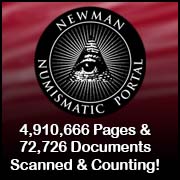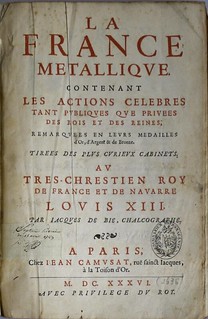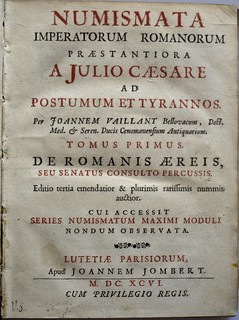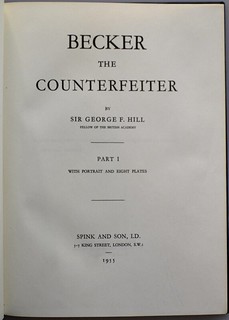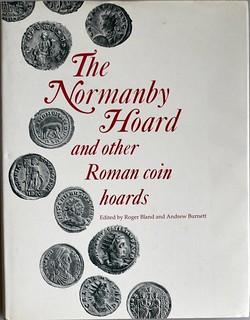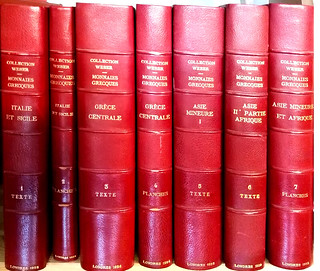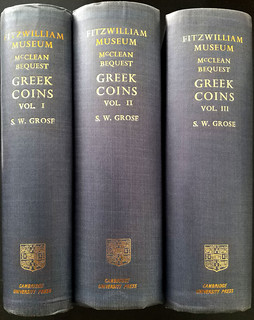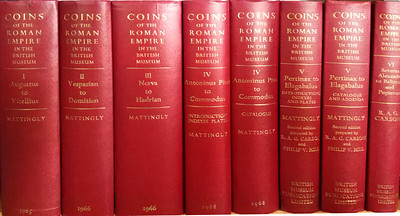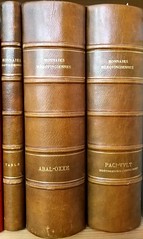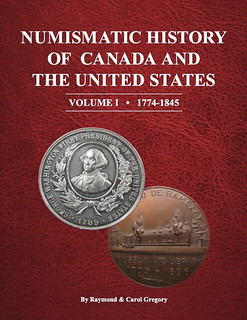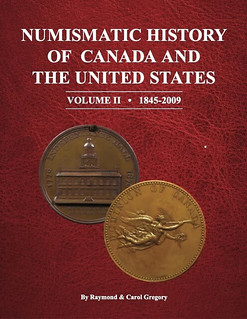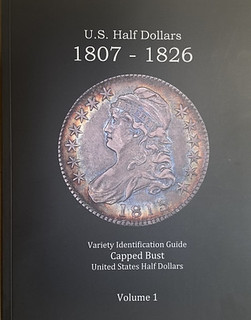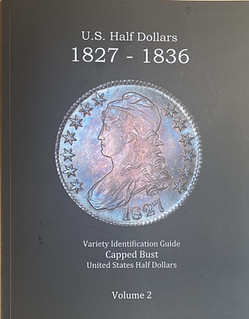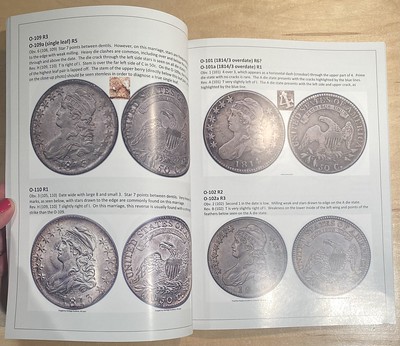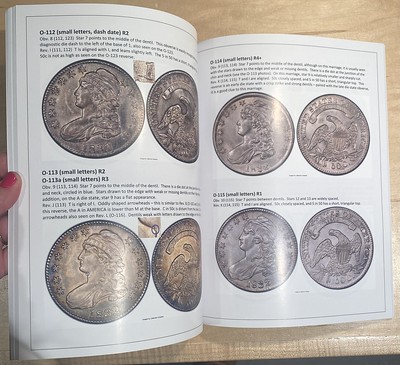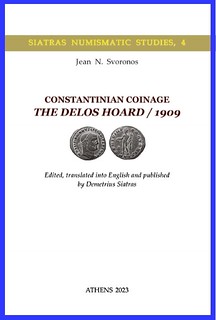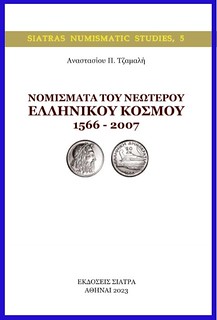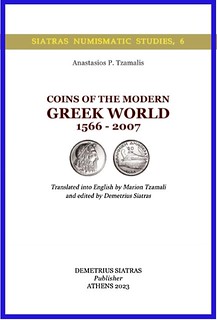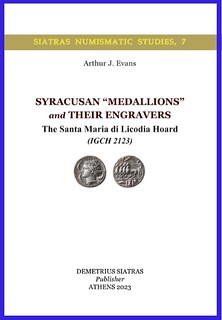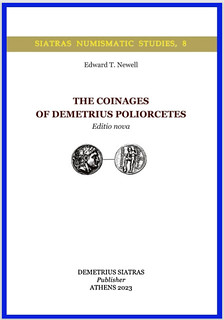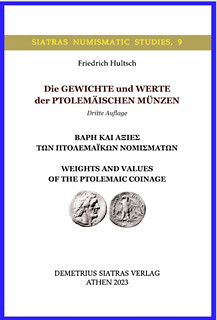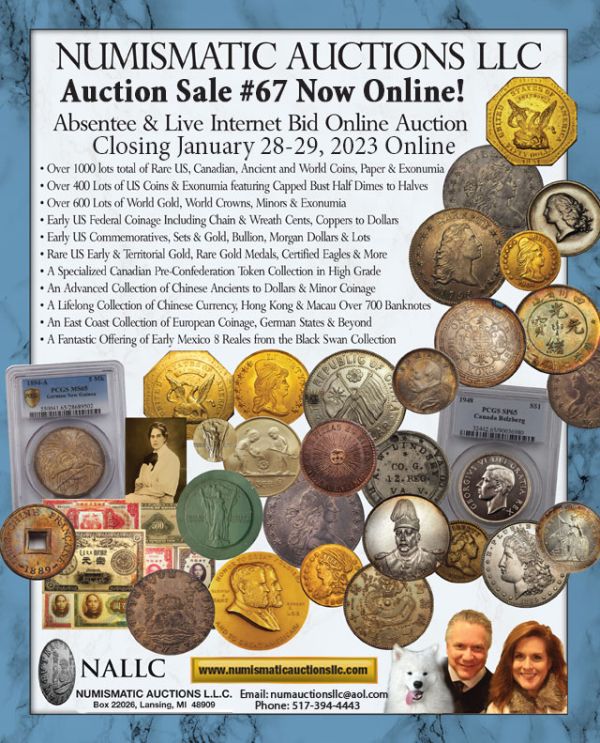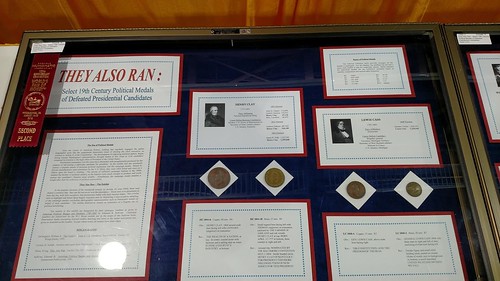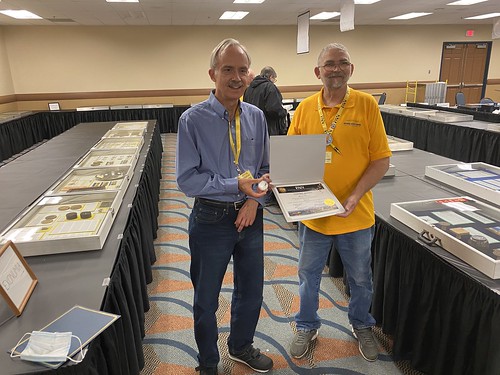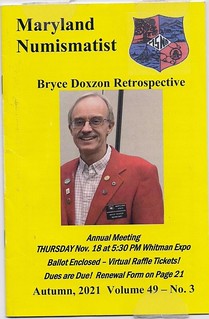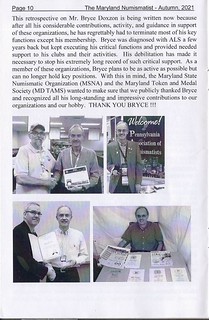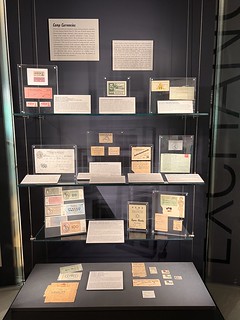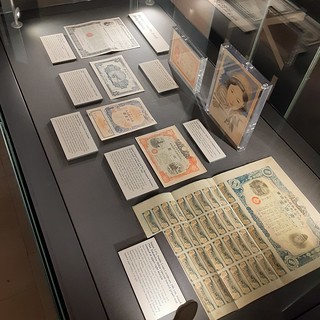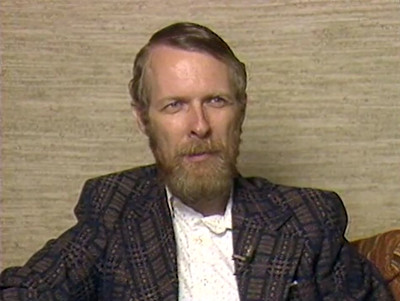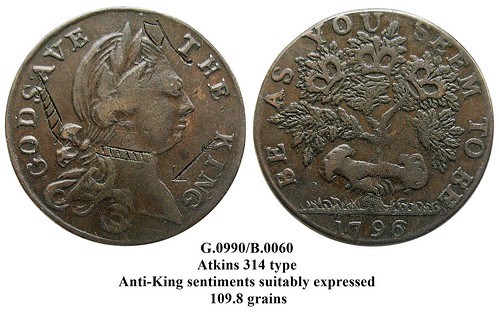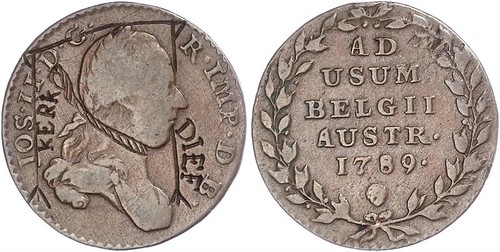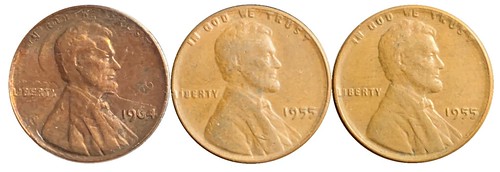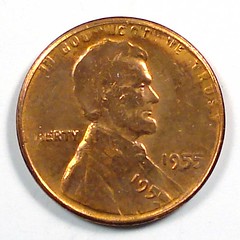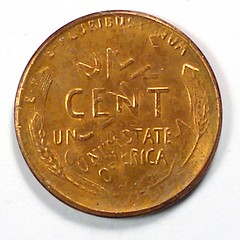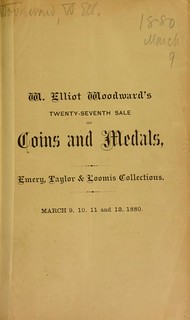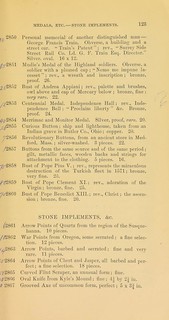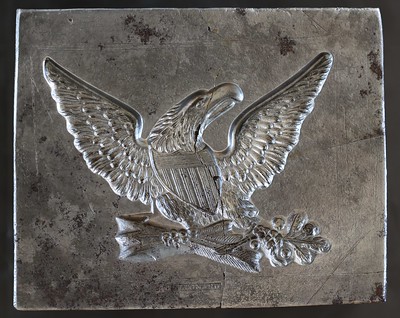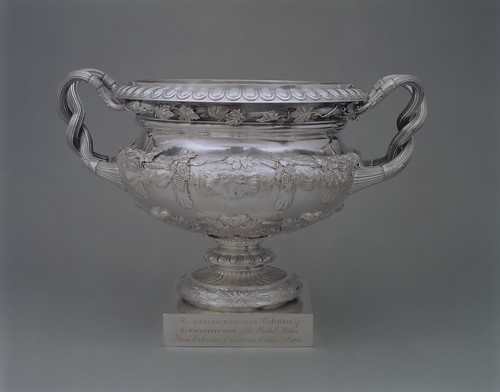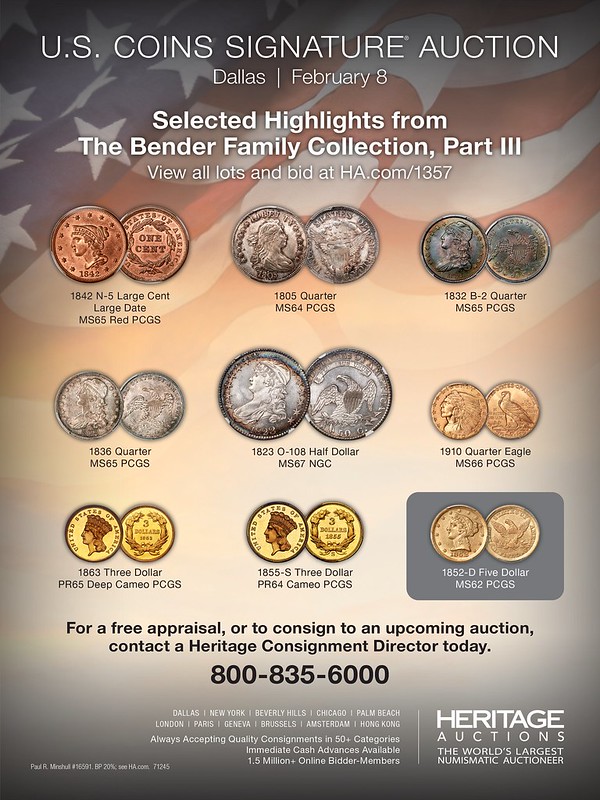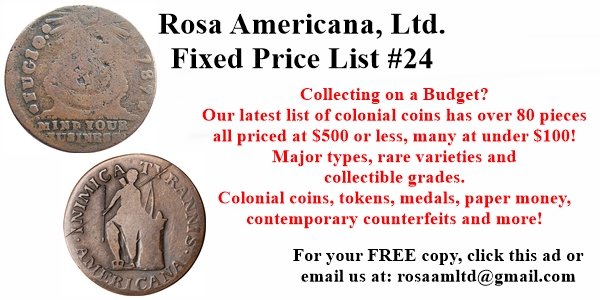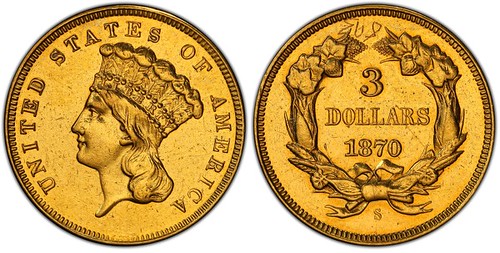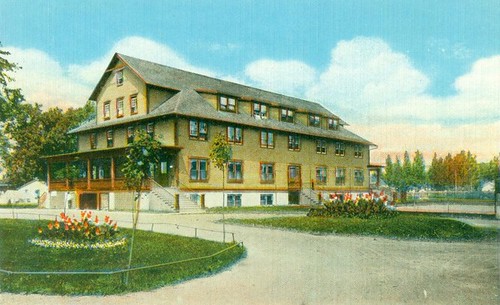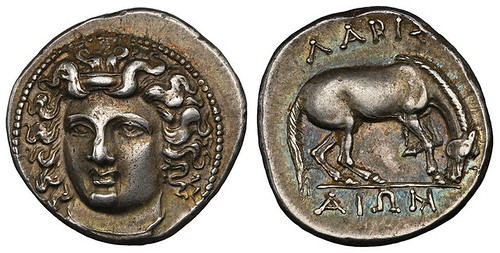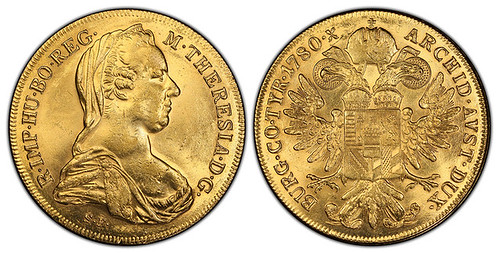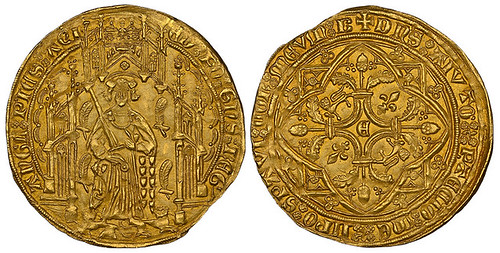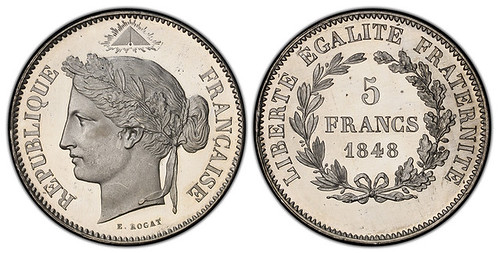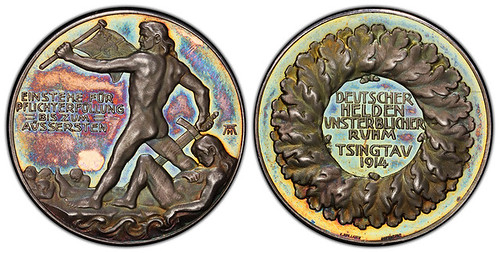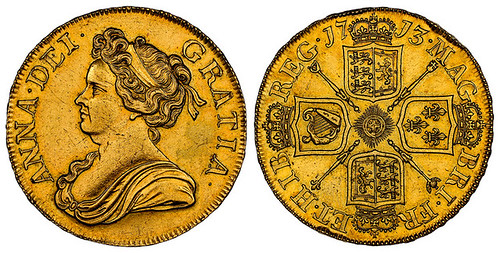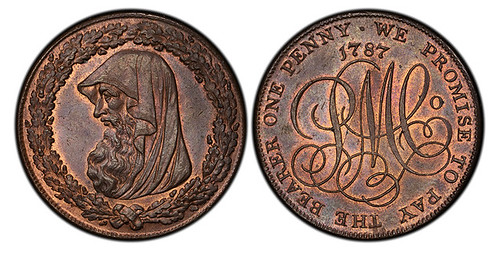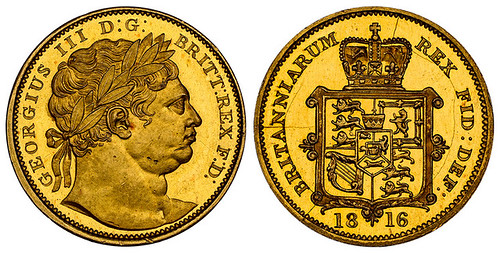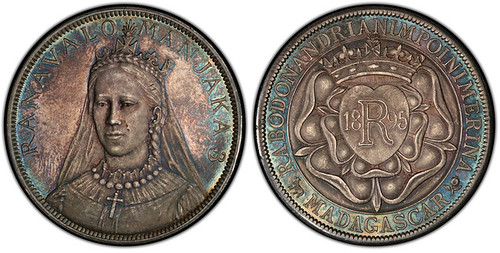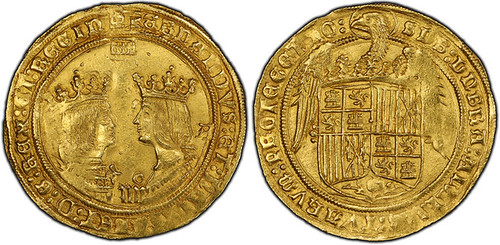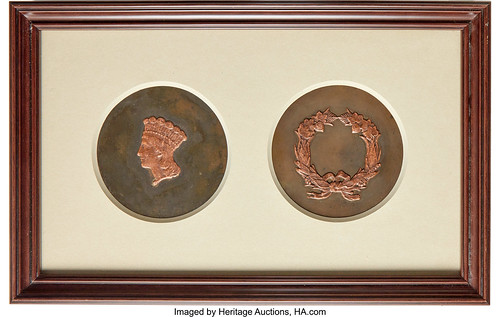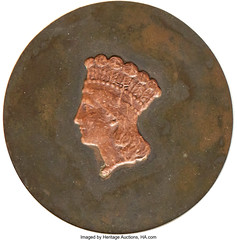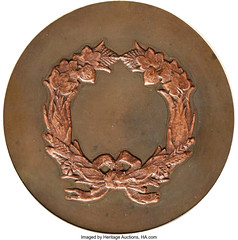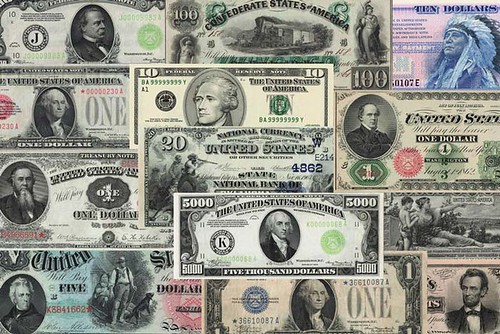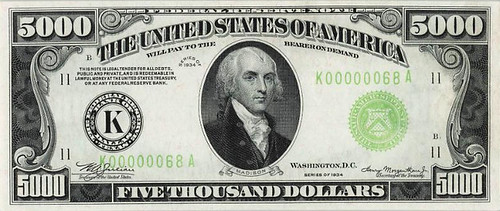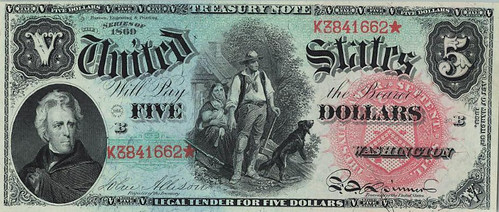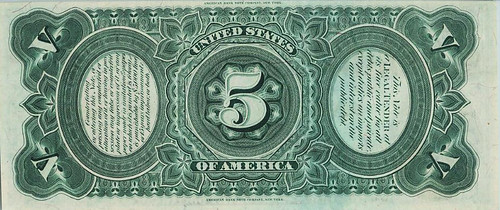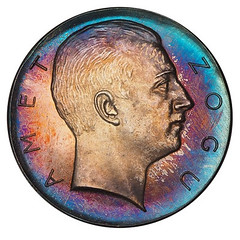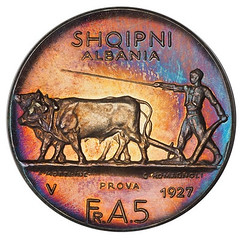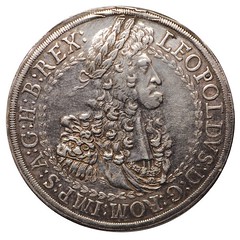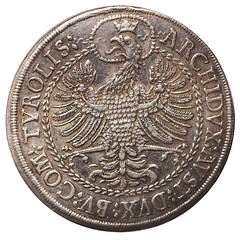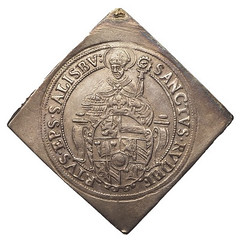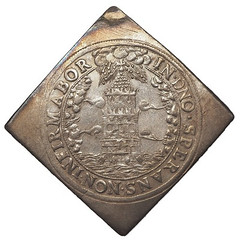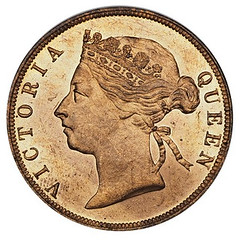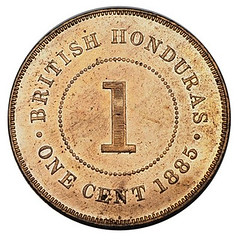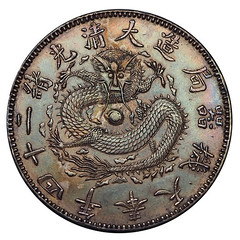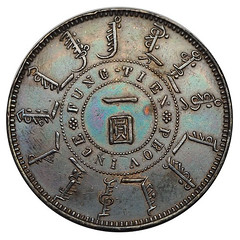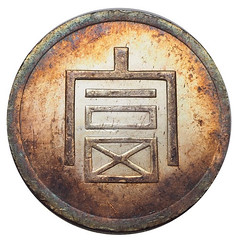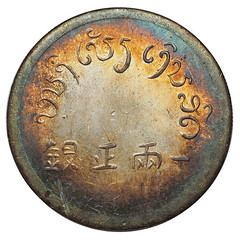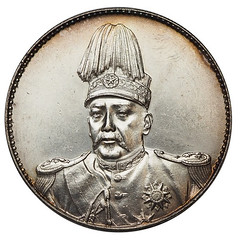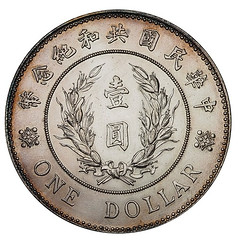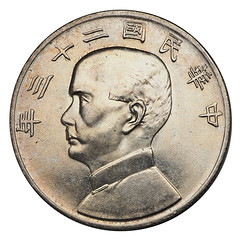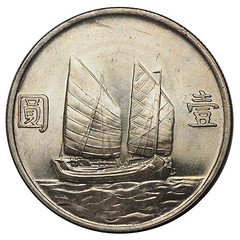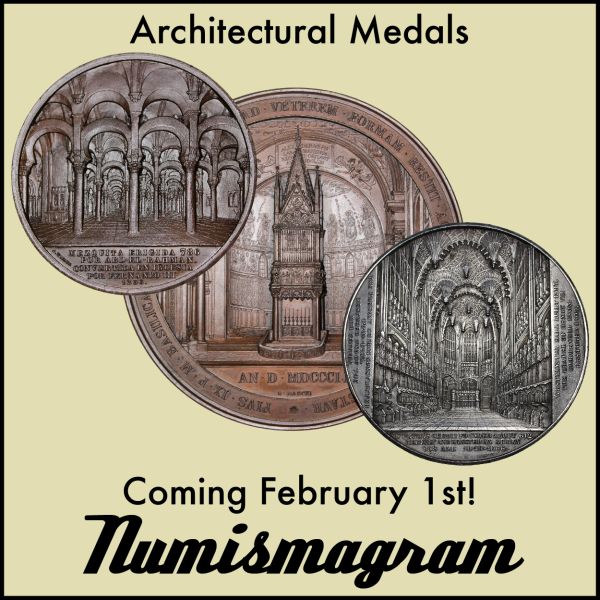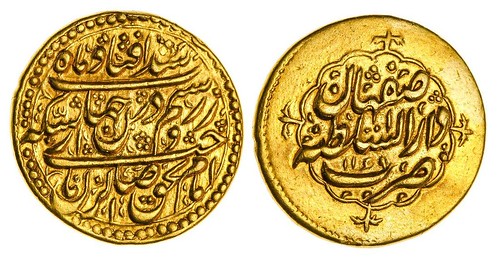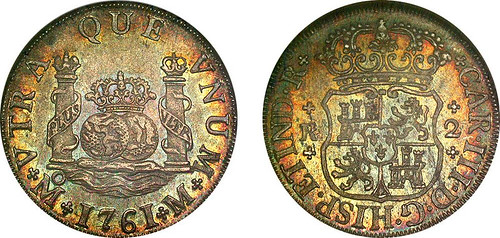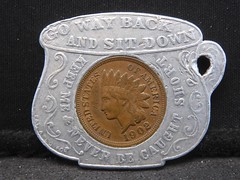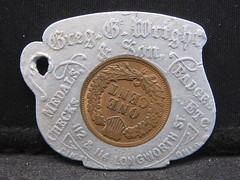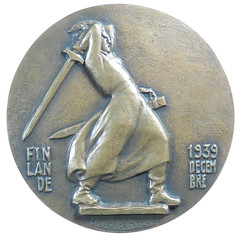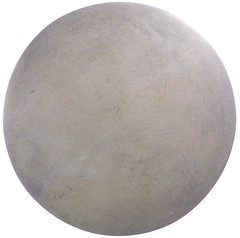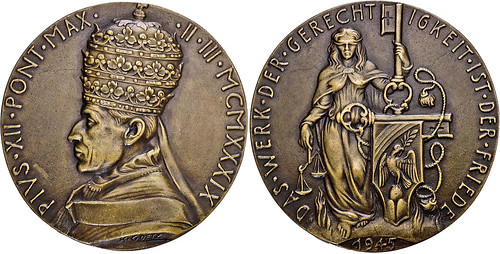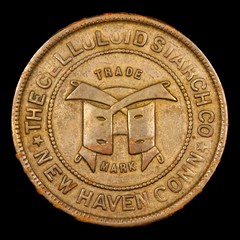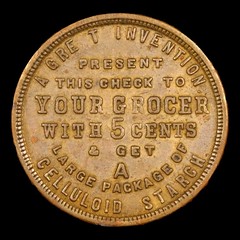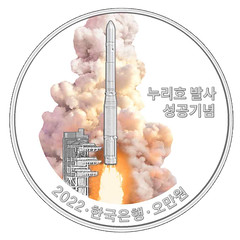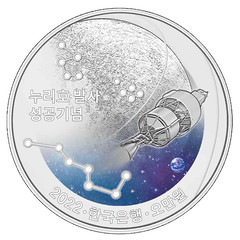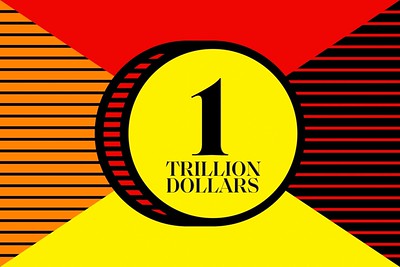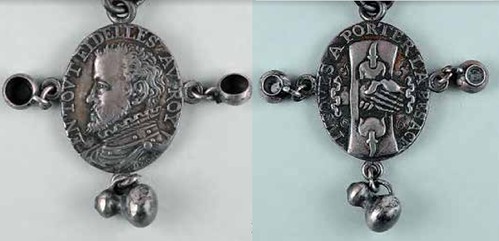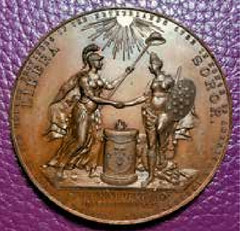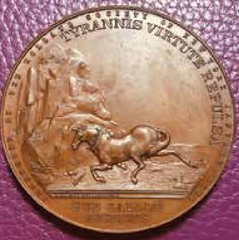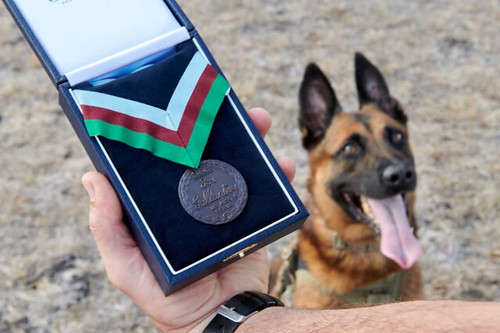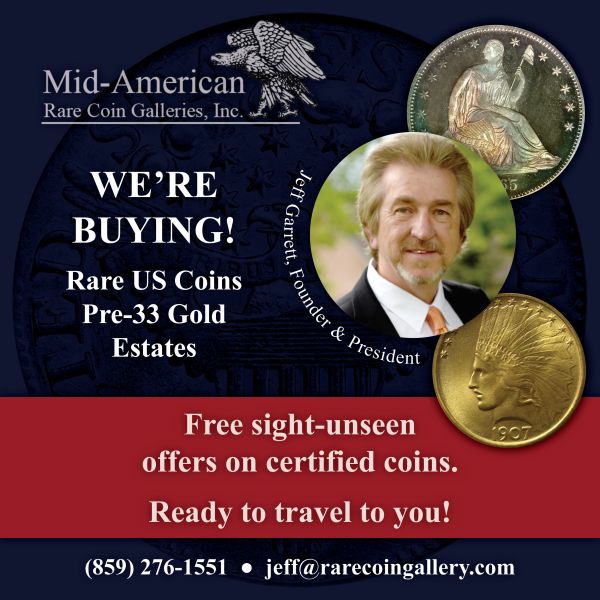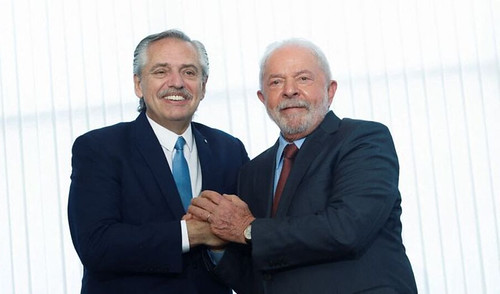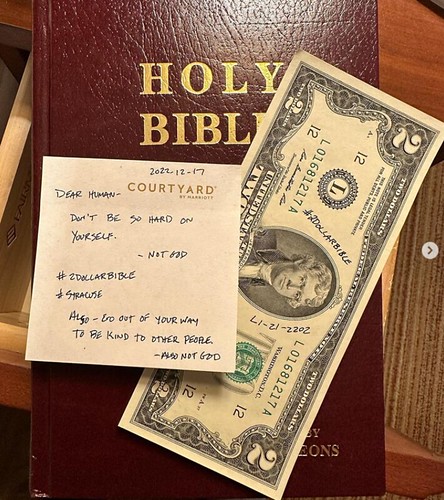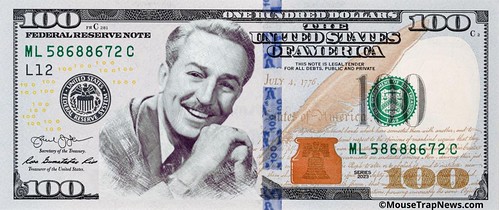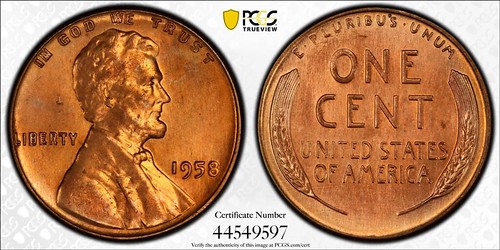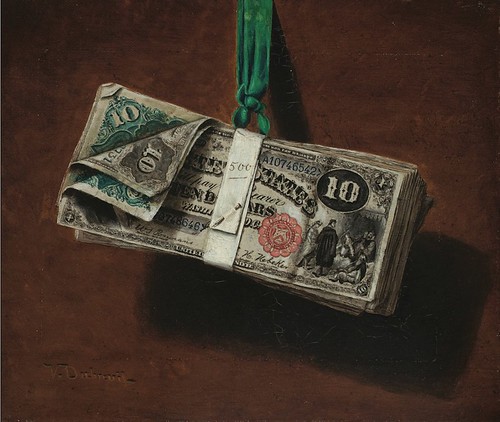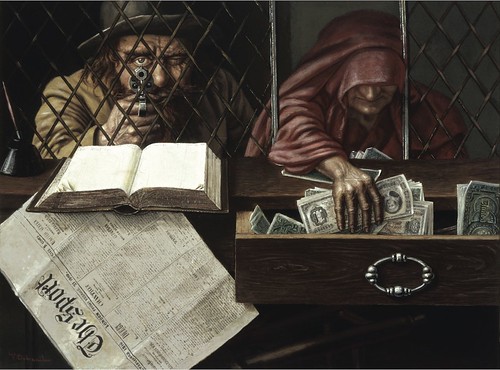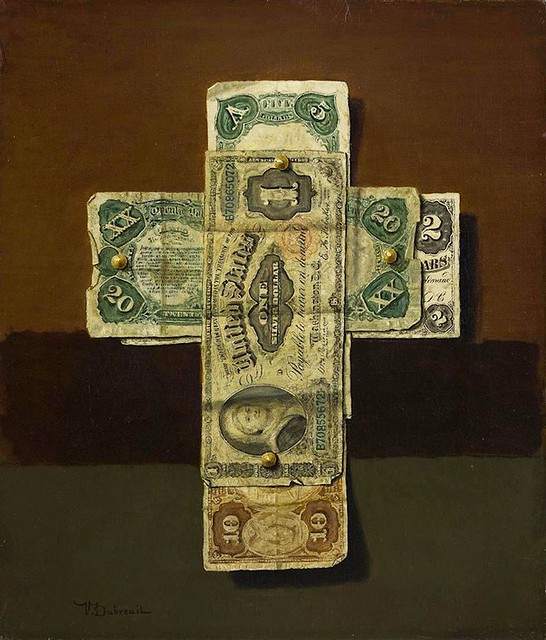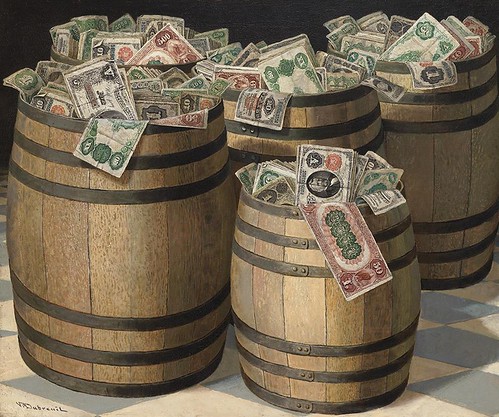
Visit our NBS Sponsors




About UsThe Numismatic Bibliomania Society is a non-profit association devoted to the study and enjoyment of numismatic literature. For more information please see our web site at coinbooks.org SubscriptionsThose wishing to become new E-Sylum subscribers (or wishing to Unsubscribe) can go to the following web page link MembershipThere is a membership application available on the web site Membership Application To join, print the application and return it with your check to the address printed on the application. Print/Digital membership is $40 to addresses in the U.S., and $60 elsewhere. A digital-only membership is available for $25. For those without web access, write to: Charles Heck, Treasurer AsylumFor Asylum mailing address changes and other membership questions, contact Chuck at this email address: treasurer@coinbooks.org SubmissionsTo submit items for publication in The E-Sylum, write to the Editor at this address: whomren@gmail.com BUY THE BOOK BEFORE THE COINSale CalendarWatch here for updates! |
- WAYNE'S WORDS: THE E-SYLUM JANUARY 29, 2023
- KOLBE & FANNING BUY OR BID SALE 20 CLOSING
- MÜNZEN GUT-LYNT LITERATURE AUCTION 9
- NEW BOOK: NUMISMATIC HISTORY OF CANADA AND U.S.
- NEW BOOKS: BUST HALF DOLLAR VARIETY GUIDE
- NEW SIATRAS BOOKS PUBLICATIONS
- BOOK REVIEW: WHEN MONEY TALKS
- BOOK REVIEW: COIN HOARDS AND HOARDING
- BRYCE FRANKLIN DOXZON (1960-2023)
- NNP STORIES FROM WORLD WAR II EXHIBIT
- VIDEO: ROBERT W. JULIAN
- NOTES FROM E-SYLUM READERS: JANUARY 29, 2023
- ENGRAVER ALLEN LEONARD'S WEBSTER VASE
- VOCABULARY TERM: MINT ERROR
- WHAT WAS THE FIRST JUNIOR COIN CLUB?
- THE CELINA COIN COMPANY
- ATLAS NUMISMATICS JANUARY 2023 UPDATE
- LONGACRE HARD WAX MODELS OFFERED
- WORLD BANKNOTE AUCTIONS US SALE 1
- NUMISMATIC AUCTIONS SALE 67 WORLD HIGHLIGHTS
- DAVISSONS AUCTION 42 ANNOUNCED
- NUMISMATIC NUGGETS: JANUARY 29, 2023
- SOUTH KOREA'S NEW ROCKET COINS
- THE MYTHICAL TRILLION-DOLLAR COIN
- OKLAHOMA SENATOR PROMOTES BULLION IDEA
- HOLLAND SOCIETY OF NEW YORK SOUVENIRS
- DICKIN MEDAL FOR BOMB-SNIFFING DOG BASS
- ARGENTINA, BRAZIL COMMON CURRENCY?
- ARGENTINE BANKS RUNNING OUT OF ROOM FOR NOTES
- LEAVING $2 BILLS INSIDE HOTEL BIBLES
- THE WALT DISNEY $100 BILL
- LOOSE CHANGE: JANUARY 29, 2023
- THE MONEY ART OF VICTOR DUBREUIL
Click here to read the thin version on the web
Click here to subscribe
Click here to access the complete archive
To comment or submit articles, reply to whomren@gmail.com
Content presented in The E-Sylum is not necessarily researched or independently fact-checked, and views expressed do not necessarily represent those of the Numismatic Bibliomania Society.
WAYNE'S WORDS: THE E-SYLUM JANUARY 29, 2023
 New subscribers this week include:
Caitlin Smith of the American Numismatic Society.
Welcome aboard!
New subscribers this week include:
Caitlin Smith of the American Numismatic Society.
Welcome aboard!
Thank you for reading The E-Sylum. If you enjoy it, please send me the email addresses of friends you think may enjoy it as well and I'll send them a subscription. Contact me at whomren@gmail.com anytime regarding your subscription, or questions, comments or suggestions about our content.
This week we open with two numismatic literature sales, lots of new books, two reviews, another obituary, updates from the Newman Numismatic Portal, and more.
Other topics this week include lettered-edge bust half dollars, coin hoards, engraver Allen Leonard, mint errors, Junior Coin Clubs, the Celina Coin Co. fixed price and auction offerings, South Korea's rocket coins, trillion-dollar coins, the Holland Society of New York, a new Dickin Medal, two-dollar bills, and the money art of Victor Dubreuil.
To learn more about freaks and fidos, the Rodney Dangerfield of engravers, the Delos hoard, Syracusan medallions, Bryce Doxzon, Robert W. Julian, Ted and Carl Brandts, the Webster Vase, the Madagascar Dollar the Defense of Finland medal, the Walt Disney $100 bill and the Money Dream Pillow's wealth energy, read on. Have a great week, everyone!
Wayne Homren
Editor, The E-Sylum
KOLBE & FANNING BUY OR BID SALE 20 CLOSING
Reminder: Kolbe & Fanning's twentieth "Buy or Bid Sale" closes tomorrow, January 30, 2023. -Editor
Buy or Bid #20 Closes Tomorrow
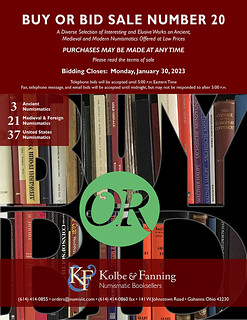 Kolbe & Fanning Numismatic Booksellers have announced our latest
Kolbe & Fanning Numismatic Booksellers have announced our latest Buy or Bid Sale,
which will close tomorrow, Monday, January 30, 2023. With hundreds of new additions, the sale focuses on modestly priced books, giving collectors an opportunity to add to their libraries at minimal cost.
The sale includes over 1400 works on ancient, medieval and modern coins, as well as general works, periodicals and sale catalogues. Buy
prices have been kept low to promote sales. To further encourage participation, the firm is offering free domestic shipping to bidders spending at least $300; there is also no packing and processing fee for this sale. Again, please read the Terms of Sale before participating.
As the name of the sale suggests, customers may bid on items they wish to acquire or buy them outright at the published price. The Terms of Sale will give full instructions on how to participate: please read it carefully.
There is no printed catalogue. The PDF catalogue is available now for downloading from the Kolbe & Fanning website at numislit.com. Please send all bids to orders@numislit.com or use the bid sheet included at the end of the PDF catalogue.
To read the complete catalog, see:
https://www.numislit.com/images/upload/kolbefanningbob20.pdf
To read the earlier E-Sylum article, see:
KOLBE & FANNING BUY OR BID SALE NUMBER 20
(https://www.coinbooks.org/v26/esylum_v26n04a02.html)
THE BOOK BAZARRE
MÜNZEN GUT-LYNT LITERATURE AUCTION 9
The Germany-based MÜnzen Gut-Lynt auction house is holding a sale of numismatic literature closing January 29, 2023. Here are some lots that caught my eye. -Editor
Lot 9 DE BIE, J. La France metallique, contenant les actions celebres tant publiques que privees des rois et des reines remarquees en leurs medailles d'or, d'argent et de bronze. Paris 1636. 396 S., 131 Tfn. Ganzledereinband der Zeit, Buchrücken bestoßen. III-II Ex libris "Bibliotheca Magnia. Rothomagensis 1837".
To read the complete lot description, see:
https://auktionen.gut-lynt.de/de-de/lot?$page=1&$maxpagesize=20&$sortby=lot_number&$sortdir=asc&$goto=14385&cat_id=9
Lot 21 VAILLANT, J. Numismata Imperatorum Romanorum Praestantiora. A Julio Caesare ad Postumum usque. Tomus primus. De Romanis Aereis... Paris 1696. Engraving, 256 pages with numerous engravings. Half leather, bumped and content just trimmed. IV-III
To read the complete lot description, see:
https://auktionen.gut-lynt.de/de-de/lot?$page=1&$maxpagesize=100&$sortby=lot_number&$sortdir=asc&$goto=14396&cat_id=9
Lot 24 HILL, GF Becker the Counterfeiter. Reprint Brussels 1961 of the London 1955 edition. 2 volumes. 72 p., 8 tfn.; 39 p., tfn. 9-19 Bound in a full linen ribbon. II
To read the complete lot description, see:
https://auktionen.gut-lynt.de/de-de/lot?$page=1&$maxpagesize=100&$sortby=lot_number&$sortdir=asc&$goto=14399&cat_id=9
Lot 51 BLAND, R./ BURNETT, A. The Normanby Hoard and other Roman Coin Hoards. London 1988. 238 pp.; 40 pn. full linen II
To read the complete lot description, see:
https://auktionen.gut-lynt.de/de-de/lot?$page=1&$maxpagesize=100&$sortby=lot_number&$sortdir=asc&$goto=15294&cat_id=9
Lot 101 FORRER, L. The Weber Collection. Greek Coins. 3 Bände, London 1922-1929. Frontispiz, XVI, 377 S.; 69 Tfn.; 579 S.; Tfn. 70-171; 473 S.; S. 477-996; Tfn. 172-317. In sieben Halblederbänden gebunden, minimal bestoßen. I (7)
To read the complete lot description, see:
https://auktionen.gut-lynt.de/de-de/lot?$page=2&$maxpagesize=100&$sortby=lot_number&$sortdir=asc&$goto=14468&cat_id=9
Lot 118 GROSE, SW Catalog of the McLean Collection of Greek Coins. 3 volumes, Cambridge 1923-1929. X, 380 p., 111 ptn.; 563 p., pl. 112-248; VI, 507 p., 380 p. Linen, minimally bumped. Uniform all-linen with gold trim at the top. II-I (3)
To read the complete lot description, see:
https://auktionen.gut-lynt.de/de-de/lot?$page=2&$maxpagesize=100&$sortby=lot_number&$sortdir=asc&$goto=14484&cat_id=9
Lot 300 MATTINGLY, H. Coins of the Roman Empire in the British Museum. 6 volumes in 8 parts, London 1965-1976 reprint of the London 1923-1962 edition. full linen Volume I with slightly damaged spine. I (8)
To read the complete lot description, see:
https://auktionen.gut-lynt.de/de-de/lot?$page=3&$maxpagesize=100&$sortby=lot_number&$sortdir=asc&$goto=14658&cat_id=9
Lot 363 BELFORT, A. DE. Description generale des monnaie Merovingiennes par ordre alphabetique des ateliers. Paris 1892-1895. 3 volumes. Volume 1: ABAL-OXXE, VIII, 484 p., 6 tfn, 464 p.; Volume 2: PACI-VVLT, Indéterminées - Supplement, 464 p., 475 p.; Volume 3: Table, 290 pp. Bound in uniform half leather. II
To read the complete lot description, see:
https://auktionen.gut-lynt.de/de-de/lot?$page=4&$maxpagesize=100&$sortby=lot_number&$sortdir=asc&$goto=14712&cat_id=9
NEW BOOK: NUMISMATIC HISTORY OF CANADA AND U.S.
Ray and Carol Gregory of Alliston, ON, Canada have published a new two-volume work on the Numismatic History of Canada and the United States. -Editor
Numismatic History of Canada and the United States Vol 1 and Vol 2
Authored By: Raymond Gregory, Carol Gregory
Self-Published: Raymond & Carol Gregory
Price: $189.95 CAD
8.5 x 11 inches glossy softcover)
Pages: Vol 1 448; Vol 2 510
ISBN: 978-1-7782230-0-6
Print Run: 100
Targeted Audience: Numismatist and History Buffs
Hot of the press are 100 copies of Numismatic History of Canada and United States Vol
1 and Vol 2,
available through our website www.numismaticpublishing.com
Our book is self-published, printed in Waterloo, ON and bound in Aylmer, ON.
The red cover was designed by the Art Department of Westmount Signs & Printing.
Features
- 337 color numismatic photos printed larger than the actual size to exemplify artistic details
- 463 illustrations such as photos of designers, engravers, and subject matter to further enhance articles
- Example: we show pictures of the actual president's home depicted on the obverse of the Lovett's presidential residence series
- Featured in Vol. 1: the Gift of Franklin award medals for boys and Boston School City medals for girls
- Featured in Vol. 1: are seven Chateau de Ramezay medals and a Cartier, Montcalm, Chaplain Plaque issued by the Association of French-speaking Physicians of North America
- Featured in Vol. 2: are ten medals of the Frederic Remington's Old American Western Heritage Medal Series issued by Century 21 Club, New York, NY
- Featured in our Franklin D. Roosevelt section are two Eleanor Roosevelt cast bronze medals
- References are given at the end of each article to supply the reader with sources for further information
- Easy to find information using Table of Contents, Glossary, Index and List of Figures
ABOUT THE AUTHORS
Raymond Gregory worked for the York Region School Board in Ontario and retired as a
Head Custodian and a Fourth-Class-Engineer. Ray taught coin collecting to students in
various elective school programs. Ray and Carol displayed Colonial Coinage at Fort York,
Toronto, Niagara-On-the Lake Museum, and the Simcoe County Museum, Barrie, ON.
Ray wrote articles published in the Royal Canadian Numismatic Journal and is a 47 year
member of the Royal Canadian Numismatic Association and an American Numismatic
Association member since 2014.
Carol Gregory was a Library Technician for the Georgian College Library, Barrie, ON and the RCNA Librarian from Sept. 1980 to June 1991. Carol photographed all the numismatic items contained in the two volumes. Carol is also a 47 year Member of Royal Canadian Numismatic Association.
For more information, or to order, see:
https://www.numismaticpublishing.com/
NEW BOOKS: BUST HALF DOLLAR VARIETY GUIDE
Robert Powers is publishing a series of variety guides for U.S. coins. The latest two volumes cover Lettered Edge Capped Bust Half Dollars and are available through David Kahn Rare Coins. There are priced at $125 plus $5 shipping each. I've seen the books, and the photos are large, beautiful and in full color. Ordering information is below. -Editor
U.S. Capped Bust Half Dollars 1807 - 1826 Variety Identification Guide (Volume I)
U.S. Capped Bust Half Dollars 1827 - 1836 Variety Identification Guide (Volume II)
The primary purpose of this guide is rapid variety identification – while other publications are excellent for inviting in depth home study, this guide is perfect for portability, heavy on-the-go usage, and quick attribution. The author of this book has had a strong interest in Early U.S. coins for over 30 years. He set out to write this series of books because he has wanted to read them for many years, and finally gave up on waiting for someone else to write them. Inside, you will find a comprehensive collection of the highest quality, full color, high resolution modern photos available anywhere, which will make attributing your Capped Bust Half Dollars easier than ever before. Careful attention to detail was considered in the selection of these photos for only those which show the greatest of useful detail in helping with your attribution and die stage recognition.
This guide is written in a classical, though modernized attribution guide format, meaning that you are simply presented with a photo and description of each die. The descriptions of each die are in plain English, designed for those who are complete beginners, as well as those with intermediate and advanced levels of knowledge. Attributing Bust Halves (or any coin series) begins with taking in the whole picture of the coin. The position of all of the features relative to the other features on each individual coin should be visually taken in the same way that one recognizes the face of a familiar person. The positions of the stars, leaves, berries, letter and number spacing, etc. are universal observations for every attribution. The text descriptions will point out specific, unique features found on each and every die to further guide you. Also, the best kept secret in variety attribution are the dentil alignments relative to the stars and letters below them. Every effort was made to present photos with maximum dentil visibility for this underrated purpose. Use the dentils as your compass. Once you dive in, you will understand this ‘compass concept' all too well.
For more information or to order individually or as a set, see:
U.S. Capped Bust Half Dollars 1807 - 1826 Variety Identification Guide, by Robert Powers
(https://www.davidkahnrarecoins.com/u-s-early-half-dollars-1794-1807-variety-identification-guide-by-robert-powers-1.html)
U.S. Capped Bust Half Dollars 1827 - 1836 Variety Identification Guide, by Robert Powers
(https://www.davidkahnrarecoins.com/u-s-early-half-dollars-1794-1807-variety-identification-guide-by-robert-powers-2.html)
U.S. Capped Bust Half Dollars, Volumes 1 & 2 Variety Identification Guides, by Robert Powers
(https://www.davidkahnrarecoins.com/u-s-large-cents-volumes-1-2-variety-identification-guides-by-robert-powers-1.html)
To read the earlier E-Sylum articles, see:
NEW BOOK: HALF CENTS 1793-1857 VARIETY GUIDE
(https://www.coinbooks.org/v25/esylum_v25n32a04.html)
NEW BOOK: 1793-1795 LARGE CENT VARIETY GUIDE
(https://www.coinbooks.org/v23/esylum_v23n15a05.html)
NEW BOOK: LARGE CENT 1793-1814 VARIETY GUIDE
(https://www.coinbooks.org/v23/esylum_v23n50a02.html)
NEW BOOK: U.S. LARGE CENTS, 1816-1839
(https://www.coinbooks.org/v25/esylum_v25n13a04.html)
NEW BOOK: HALF DOLLARS 1794-1807 VARIETY GUIDE
(https://www.coinbooks.org/v25/esylum_v25n32a05.html)
NEW SIATRAS BOOKS PUBLICATIONS
Bruce Perdue passed along an announcement from Demetrius Siatras of Siatras Books in Athens about a number of new titles on numismatics and sigillography. Thanks. -Editor
# SNS004.
Jean N. Svoronos, CONSTANTINIAN COINAGE - The Delos Hoard / 1909
Athens, 2023. In English. Soft cover, 24 cm, 96 pp. EUR 32.– FREE SHIPPING WORLDWIDE.
To order through PayPal:
https://paypal.me/DemetriusSiatras/32.00
# SNS005.
Anastasios Tzamalis, TA ΝΟΜΙΣΜΑΤΑ ΤΟΥ ΝΕΩΤΕΡΟΥ ΕΛΛΗΝΙΚΟΥ ΚΟΣΜΟΥ 1566 – 2007
Athens, 2023. In Greek. Soft cover, 24 cm, 304 pp., ill. EUR 64.– FREE SHIPPING WORLDWIDE.
To order through PayPal:
https://www.paypal.com/paypalme/DemetriusSiatras/64.00
# SNS006.
Anastasios Tzamalis, COINS OF THE MODERN GREEK WORLD 1566 – 2007
Athens, 2023. The English version of the previous title. Includes the coins of Cyprus. Soft cover, 24 cm, 304 pp., ill. EUR 64.– FREE SHIPPING WORLDWIDE.
To order through PayPal:
https://www.paypal.com/paypalme/DemetriusSiatras/64.01
# SNS007.
Arthur J. Evans, SYRACUSAN MEDALLIONS
and THEIR ENGRAVERS - The Santa Maria di Licodia Hoard (IGCH 2123)
Athens, 2023. Soft cover, 24 cm, 192 pp., ill. EUR 48.– FREE SHIPPING WORLDWIDE.
To order through PayPal:
https://www.paypal.com/paypalme/DemetriusSiatras/48.00
# SNS008.
Edward T. Newell, THE COINAGES OF DEMETRIUS POLIORCETES - Editio nova
Athens, 2023. Soft cover, 24 cm, 224 pp., ill. EUR 54.– FREE SHIPPING WORLDWIDE.
To order through PayPal:
https://www.paypal.com/paypalme/DemetriusSiatras/54.00
# SNS009.
Friedrich Otto Hultsch, Die Gewichte und Werte der ptolemäischen Münzen, 3. Aufl. = Βάρη και αξίες των πτολεµαϊκών νοµισµάτων = Weights and Values of the Ptolemaic Coinage
Athens, 2023. In German, Greek and English. Soft cover, 24 cm, 160 pp., ill. EUR 39.– FREE SHIPPING WORLDWIDE.
F.O. Hultsch (1833-1906) is credited with a series of excellent works, among them the famous ''Griechische und römische Metrologie'' (Berlin 1862). The first edition of the current work was published by Teubner under the title ''Die ptolemäischen Münz- und Rechnungswerte'' (Leipzig, 1903) and then it was also reprinted in the Abhandl. Kön. Sächs. More than 25 reprints followed during the 20th century, despite the fact that Hultsch had in part revised the text of the first edition, just before his death in 1906. In 1904, Svoronos published his great work on the coins of the Ptolemies, in three volumes.
Svoronos had also planned a French edition of this book, but finally he preferred to proceed to the edition of a revised fourth volume in German, four years later; in the foreword he writes that six months before the release of the Greek edition, the German metrologist sent him a copy of his study. One of the main differences of the fourth volume of Svoronos, in comparison to the previous ones, would be the addition of a chapter on the Ptolemaic metrology; but the reading of Hultsch's study convinced him that the two texts were incompatible. Therefore, Svoronos wrote a long letter to Hultsch, exposing his opinions and urging the German savant to revise his treatise in the light of the new data; he also added that he could omit his own chapter on metrology from the fourth volume and replace it with an appendix containing the revised text by Hultsch; and the great Hultch consents and — when after a few months receives the first three volumes of Svoronos — says that the new finds and the new classification was a pleasant surprise to him! Unfortunately, Hultsch was already seriously ill; despite his ilness, he managed to finish it but could not correct the proofs sent from Athens by Svoronos; this was done by Franz Poland who also announced to Svoronos the death of the German savant.
The new text was published as an Appendix in the fourth volume of Svoronos (''Die Münzen der Ptolemaeer'', 1908); since actually it was the second edition of the 1903 study, we may consider the current edition as the third one to which translations in modern Greek and English have been added.
To order through PayPal:
https://www.paypal.com/paypalme/DemetriusSiatras/39.00
The previous three volumes of the series are also available:
# SNS001.
G.P. Oeconomos, TO XAΛΚΟΥΝ KOMMA - THE PELLA FIND (1914) AND THE COPPER COINAGE OF CASSANDER
Athens, 2017. Hard cover+jacket, 24 cm, 72 pp., ill. EUR 48.– FREE SHIPPING WORLDWIDE.
To order through PayPal:
https://www.paypal.com/paypalme/DemetriusSiatras/48.01
# SNS002.
Jean N. Svoronos, THE MYRON HOARD / 1914 (IGCH 62)
Athens, 2019. Soft cover, 24 cm, 200 pp., ill. EUR 64.– FREE SHIPPING WORLDWIDE.
To order through PayPal:
https://www.paypal.com/paypalme/DemetriusSiatras/64.02
# SNS003.
Edward T. Newell, LATE SELEUCID MINTS IN AKE-PTOLEMAIS AND DAMASCUS - Editio nova
Athens, 2019. Soft cover, 24 cm, 136 pp., ill. EUR 52.– FREE SHIPPING WORLDWIDE.
To order through PayPal:
https://www.paypal.com/paypalme/DemetriusSiatras/52.00
# S6137.
A.K. Wasileiou-Seibt, Byzantinische Bleisiegel der Sammlung Gert Boersema
Thessalonica, 2022. In German. Hard cover+jacket, 25 cm, 192 pp., ill. in colour. EUR 64.– SHIPPING COST INCL.
Bibliographie und Siglenverzeichnis // Abkurzungsverzeichnis und Transkriptionszeichen // KATALOG: I. MILITARS IN HAUPTSTADT UND PROVINZ, II. ZIVILE BEAMTE IN HAUPTSTADT UND PROVINZ, III. DOMANEN, IV. FUNKTIONARE DER KIRCHE, V. KLOSTER, VI. VOR- UND FAMILIENNAMEN. ENGLISH SUMMARY. INDICES.
To order through PayPal:
https://www.paypal.com/paypalme/DemetriusSiatras/64.00
# S7541.
MEMORY AND IMPRESSION - An itinerary through the Peloponnese in the company of ancient coins
Athens: Benaki Museum, 2022. Exhibition catalogue. Bilingual (Greek-English) edition. Hard cover, 22.5x27.5 cm, 376 pp., rich ill. EUR 96.– SHIPPING COST INCL.
Presents silver and bronze coins that introduce the reader to aspects of ancient Greek myths taking place in ancient territories of the Peloponnese, such as Patras, Sparta, Corinth and Tegea. The elaborated catalogue is complemented by rich illustrations and detailed bibliography.
To order through PayPal:
https://www.paypal.com/paypalme/DemetriusSiatras/96.00
# S9432
.
Nikolay Ovcharov et al, THE ANCIENT AND MEDIEVAL CITY OF PERPERIKON – I. The Acropolis
Sofia, 2021. Hard cover, 30 cm, 556 pp., ill.; net weight 2560 gr. EUR 136.– SHIPPING COST INCL.
Archaeological and numismatic report presenting the results of the excavations. In Bulgarian and (partly) in English.
Of special interest are the chapters on the Roman and Byzantine coins found on the Acropolis (pp. 175-266) and the Byzantine and Bulgarian lead seals (pp. 267-284).
To order through PayPal:
https://www.paypal.com/paypalme/DemetriusSiatras/136.00
BOOK REVIEW: WHEN MONEY TALKS
JP Koning passed along this London Review of Books review of When Money Talks by by Frank L. Holt. Thanks! -Editor
When Money Talks: A History of Coins and Numismatics
by Frank L. Holt.
Oxford, 336 pp., £25.99, October 2021, 978 0 19 751765 9
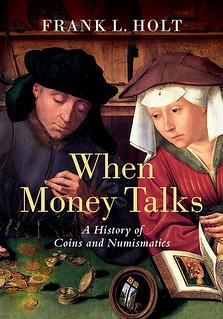 A great deal? remains to be learned, particularly where the technical study of coinage intersects with larger social and economic questions, but the work is hampered by the lowly status of numismatics in contemporary academia. Among the so-called auxiliary sciences of history, only heraldry and genealogy are taken less seriously, still carrying the stigma of antiquarianism from which epigraphy and archaeology long ago liberated themselves. All of these fields stemmed from the curiosity of Renaissance humanists and the collecting mania of noblemen with their Kunstkammern. The first serious studies of ancient coinage, on the Romans by the French humanist Guillaume Budé at the beginning of the 16th century, and on the Greeks by the Austrian Wolfgang Lazius fifty years later, were analytical and remain worth reading. But they were outshone and far outnumbered by essentially compilatory works, the long lists and catalogues that culminated in the work of Joseph Eckhel, another Austrian and curator of the imperial coin cabinet in Vienna. His Doctrina numorum veterum invented some of the classificatory principles with which we still work, for instance the sequence in which Greek coinages are presented in catalogues, clockwise from Spain to India and then back around to North Africa. Although Eckhel's work was a masterpiece, the abiding image of the numismatist was that of the antiquarian worker ant, hoarding details but not very interested in what they meant. Not even Theodor Mommsen could rescue the field, although he managed to place epigraphy at the centre of ancient historical studies.
A great deal? remains to be learned, particularly where the technical study of coinage intersects with larger social and economic questions, but the work is hampered by the lowly status of numismatics in contemporary academia. Among the so-called auxiliary sciences of history, only heraldry and genealogy are taken less seriously, still carrying the stigma of antiquarianism from which epigraphy and archaeology long ago liberated themselves. All of these fields stemmed from the curiosity of Renaissance humanists and the collecting mania of noblemen with their Kunstkammern. The first serious studies of ancient coinage, on the Romans by the French humanist Guillaume Budé at the beginning of the 16th century, and on the Greeks by the Austrian Wolfgang Lazius fifty years later, were analytical and remain worth reading. But they were outshone and far outnumbered by essentially compilatory works, the long lists and catalogues that culminated in the work of Joseph Eckhel, another Austrian and curator of the imperial coin cabinet in Vienna. His Doctrina numorum veterum invented some of the classificatory principles with which we still work, for instance the sequence in which Greek coinages are presented in catalogues, clockwise from Spain to India and then back around to North Africa. Although Eckhel's work was a masterpiece, the abiding image of the numismatist was that of the antiquarian worker ant, hoarding details but not very interested in what they meant. Not even Theodor Mommsen could rescue the field, although he managed to place epigraphy at the centre of ancient historical studies.
As well as this antiquarian taint, there is also the whiff of trade: academic numismatists have to rub shoulders with amateurs, many of whom possess great technical knowledge, and professionals who work for commercial concerns. The same can be true of art historians, but at least they often have dealings with the donor class whose private collections, through gift or loan, grace the world's museums. With coins, all but the most splendid rarities cost less than a mediocre Roman bust, while at the low end of the market, Pokémon cards are a better investment. So not just sordid but déclassé. On top of that, there is a very real problem with provenance. While dealers and auction houses keep the existing stock of ancient coins recirculating, the supply of new coins, from great rarities to the most common late Roman bronzes, comes overwhelmingly from war zones or from countries where clandestine excavation is enabled by lax law enforcement and venal officialdom. Bulgaria has for decades been the source of huge caches of Greek and Roman coins, while Syria has been disgorging bronzes by the tens of thousands with the distinctive patina that sand gives to coins.
Frank L. Holt tackles the problem in a chapter he frames as a classroom discussion between a lecturer, a preternaturally learned coin collector and students playing devil's advocate. His verdict is that we should take the curatorial approach used with dinosaur bones, where paleontologists and fossil hunters have a symbiotic and co-operative relationship. This seems less realistic in Helmand than in Wyoming. Holt has written several excellent books on Alexander the Great and his successors in Central Asia, all of them with substantial numismatic content. When Money Talks, by contrast, is rather eccentric, with puns and dad jokes and a chapter on ‘the coin's point of view'. Philip Grierson's magisterial Numismatics (1975), sadly out of print, remains a better introduction to the subject, though Holt's book is more likeable. It also conveys something very important: holding a coin that someone else held two thousand years ago creates a special feeling of connectedness. Anyone who has handed a bag of cheap Roman bronzes around a room of bored undergraduates will have seen first-hand the way it electrifies the atmosphere. Coins make history feel real. And there are an awful lot of them out there.
Ancient Roman coins in particular were mass-produced on a scale that beggars the imagination and shipped to every corner of the empire, ending up as far afield as East Africa and southern India. The Mildenhall Hoard, found in Wiltshire in 1978, probably the most famous Romano-British find, weighed 180 kg and contained more than fifty thousand low-value coins from the third century. The 1918 Komin hoard, found near the mouth of the Neretva river in Croatia, contained around three hundred thousand coins from the same era. Right now, half a million Roman coins from Egyptian hoards, mostly uncleaned and unconserved, are stored between museums in Cairo, Alexandria, Toronto and Ann Arbor. More turn up all the time. A Spanish badger made international news last year when it uncovered a hoard of several hundred coins in an Asturian cave. Even for scholars, the fact of the badger was more interesting than the utterly predictable fourth-century bronzes that made up the hoard.
What survives is thought to represent about 1 per cent of the coinage originally struck; almost all of them were part of a hoard. Stray finds – single coins lost by the roadside or dropped at the bazaar – make up a tiny percentage of survivals. Yet for most of the history of numismatics, coins have been studied individually, for their iconography, their contributions to political geography (there are, for instance, Greek cities attested only by their coins), or for what their inscriptions tell us about the structure of government or the development of rulers' titulature. Less happily, they have been used to build elaborate historical narratives of places and periods for which written evidence is virtually non-existent, like the Greco-Bactrian kingdom, most of whose rulers are known solely from coin portraits and legends. Third-century usurpers attract similar excesses. Jotapian, Uranius Antoninus, Ingenuus and Regalianus are all barely known apart from their coinages. To this list we may perhaps now add the Sponsianus whose anomalous gold coins, housed in Glasgow's Hunterian and long dismissed as modern forgeries, sparked a Twitterstorm in December, when an earth scientist suggested that mineral deposits and surface abrasion authenticated their antiquity. The jury is out – the case for forgery either modern or ancient is very strong – but even if real, the lost history of Roman Dacia they are purported to reveal is in fact pure fantasy.
To read the complete article, see:
What the Badger Found
(https://www.lrb.co.uk/the-paper/v45/n03/michael-kulikowski/what-the-badger-found)
To read the earlier E-Sylum article, see:
NEW BOOK: WHEN MONEY TALKS
(https://www.coinbooks.org/v24/esylum_v24n31a05.html)
BOOK REVIEW: COIN HOARDS AND HOARDING
The London Review of Books article also reviews a new compilation titled Coin Hoards and Hoarding in the Roman World . -Editor
Coin Hoards and Hoarding in the Roman World
edited by Jerome Mairat, Andrew Wilson and Chris Howgego.
Oxford, 368 pp., £90, May 2022, 978 0 19 886638 1
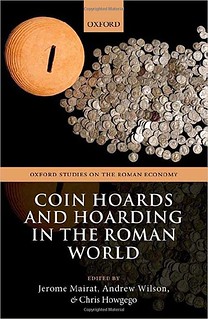 However valuable the information ancient coins provide as individual artefacts, even more valuable is what they teach us in the aggregate. A hoard can be defined as two or more coins deposited together, usually but not always intentionally, and not subsequently recovered. Since a hoard's owner usually intended to retrieve it, the non-recovery acts as proxy evidence for its historical circumstances. Broadly speaking, there are four categories of hoard, each defined by the way it was created: accidental loss, sudden response to an emergency, storage of savings, or deliberate abandonment. Each tells us different things. Accidental hoards are things like dropped purses, or the basket of coins discovered on the docks of Herculaneum, now a fused mass of bronze and silver bearing the imprint of the container that was incinerated along with its owner in the pyroclastic surge of Vesuvius. Emergency hoards are what they sound like: collections secreted to prevent discovery in a moment of crisis, often war or the threat of it. Savings hoards are surplus wealth kept in hidden reserve by their owner. Finally, there are deliberately abandoned hoards, such as grave deposits, sacrifices and votive offerings. Each type reveals different things. Accidental and emergency hoards can be dated, usually closely, by the youngest coin they contain, and offer a snapshot of the currency circulating in a particular place at a particular time. Savings hoards represent deliberate selection over time. This generally means higher rather than lower value coins, and better quality specimens, whether measured by weight, level of wear, or precious metal content. These hoards are harder to date, because their youngest coin may come from long before the time of deposition. For that reason, they don't provide a snapshot of monetary history, but they do reveal social choices about relative monetary values and economic decision-making. Finally, abandoned deposits represent another kind of deliberate selection, and were more likely to contain demonetised pieces which were no longer usable as currency.
However valuable the information ancient coins provide as individual artefacts, even more valuable is what they teach us in the aggregate. A hoard can be defined as two or more coins deposited together, usually but not always intentionally, and not subsequently recovered. Since a hoard's owner usually intended to retrieve it, the non-recovery acts as proxy evidence for its historical circumstances. Broadly speaking, there are four categories of hoard, each defined by the way it was created: accidental loss, sudden response to an emergency, storage of savings, or deliberate abandonment. Each tells us different things. Accidental hoards are things like dropped purses, or the basket of coins discovered on the docks of Herculaneum, now a fused mass of bronze and silver bearing the imprint of the container that was incinerated along with its owner in the pyroclastic surge of Vesuvius. Emergency hoards are what they sound like: collections secreted to prevent discovery in a moment of crisis, often war or the threat of it. Savings hoards are surplus wealth kept in hidden reserve by their owner. Finally, there are deliberately abandoned hoards, such as grave deposits, sacrifices and votive offerings. Each type reveals different things. Accidental and emergency hoards can be dated, usually closely, by the youngest coin they contain, and offer a snapshot of the currency circulating in a particular place at a particular time. Savings hoards represent deliberate selection over time. This generally means higher rather than lower value coins, and better quality specimens, whether measured by weight, level of wear, or precious metal content. These hoards are harder to date, because their youngest coin may come from long before the time of deposition. For that reason, they don't provide a snapshot of monetary history, but they do reveal social choices about relative monetary values and economic decision-making. Finally, abandoned deposits represent another kind of deliberate selection, and were more likely to contain demonetised pieces which were no longer usable as currency.
Collections of scholarly articles are rarely coherent, but Coin Hoards and Hoarding in the Roman World contains plenty to enlighten the non-specialist and surprise the expert. Both emergency and savings hoards can tell us a lot about coins' longevity. There was, for instance, a five to tenfold increase in circulating silver between 200 and 50 bc and no mechanism for withdrawal save natural wear and tear. Because Republican denarii were so pure, even very worn examples were hoarded well into the second century ad. Particularly large issues from the last century bc – for instance, the massive issue of slightly underweight ‘legionary' denarii struck by Mark Antony in the run-up to his final war with Octavian – distorted the record for a hundred years or more. It's not surprising that the huge sums needed to pay for a standing army of several hundred thousand men should have a dominating impact on supply in the most heavily garrisoned provinces, but consideration of things like die-links can show us how likely coins from the same issue were to stay together over time. (Die-link studies, tedious but valuable, require meticulous comparison to match coins struck from the same dies, either on both sides or on one: reverse dies, which absorbed most of the force of the hammer, wore out faster than obverses.) There are some unexpected findings when we use hoards to trace how coins circulated. We know for a fact that the emperor Postumus, who ruled a separatist Gallic regime for a decade in the third century, was recognised in Spain because a great many inscriptions tell us so. But while coins bearing Postumus' image are common in Gallic and British hoards, they are hardly found in Spanish ones. This opens up new lines of inquiry about how, or whether, Postumus paid the legionaries garrisoned at León.
Finally, evidence from accidental and emergency hoards in particular helps us understand people's actual economic lives rather than the normative lives implicit in government issues. The proliferation of unofficial coinage and the imitations of official coinage in various parts of the Roman Empire in the second, third and fourth centuries used to be interpreted as a sign of crisis (it was seen as an example of ‘siege money', or Notmünzen). Hoard evidence now shows the reason for the existence of such coins. Ancient states coined money to make payments, to assert prestige and identity, and occasionally, as in Ptolemaic Egypt, to create a closed economy, but never deliberately to enable a market economy among private individuals. This meant severe coin shortages were a frequent problem. As with the commercial tokens used in Victorian industrial cities or the boiled sweets used in lieu of small change in 1970s Italy, Roman imitative coinages weren't a sign of crisis but of a highly monetised market economy that demanded more specie than the state was able to provide. The hoard evidence from third-century Gaul and fourth-century Spain, now well studied, shows definitively that official and unofficial coinages were accepted at par and that there was no selection bias in either direction. This completely recentres the way we think about the later Roman economy.
Coin Hoards and Hoarding shows how far from antiquarian stereotypes modern numismatics have come. More important, though, it's a reminder that cheap, ugly and plentiful coins have as much to teach us as rare and priceless specimens. Like Holt's amble, this book manages to evoke the pleasures of handling ancient coins and thinking about and with them. It also reacquaints us with a way of using money with which we are rapidly losing touch.
To read the complete article, see:
What the Badger Found
(https://www.lrb.co.uk/the-paper/v45/n03/michael-kulikowski/what-the-badger-found)
For more information, or to order, see:
Coin Hoards and Hoarding in the Roman World
(https://global.oup.com/academic/product/coin-hoards-and-hoarding-in-the-roman-world-9780198866381)
BRYCE FRANKLIN DOXZON (1960-2023)
I was sorry to learn this week of the passing of Bryce Doxzon, a longtime familiar face on the coin show circuit, active for years as an exhibitor and judge. -Editor
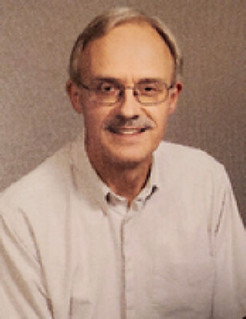 Born March 16, 1960, Bryce Franklin Doxzon passed away on New Year's morn as a result of a 3-year battle with ALS. He was a most brave & courageous fighter.
Born March 16, 1960, Bryce Franklin Doxzon passed away on New Year's morn as a result of a 3-year battle with ALS. He was a most brave & courageous fighter.
He is survived by: brother Kent, sister-in-law Debbie, niece Emily, nephew Sam; sister, Claire Simpson; brother Glenn. He is pre-deceased by his parents, Rita Mueller Doxzon & Roland Franklin Doxzon, of Catonsville.
While outwardly characterized as rather quiet & subdued, Bryce was a very loving & devoted person passionately involved in many organizations & groups as well as his family.
Bryce was a longstanding & very active member of Catonsville United Methodist Church where he played a key role in many facets of church life for which he was especially proud to have been a 22-year founding member of the Contemporary Praise & Worship Band
. The list of Bryce's involvement in CUMC as well as with other Christian community groups is too numerous to list. Suffice it to say, that he served as an obedient and faithful example of what it meant to be a follower of Jesus.
In addition to Bryce's spiritual life, he was a very dedicated numismatist with over forty years' experience. As described in MD Numismatist Retrospective
(Autumn, 2021), Bryce was not just a member of various numismatic and exonumia organizations, but was a very active
member of any organization to which he belonged. Bryce was a lifetime member of the American Numismatic Association (ANA); served as President of both the Catonsville & Baltimore Coin Clubs; and held the position of secretary to the MD State Coin Club. Exhibits in which he displayed his medals and tokens won many awards throughout the country. Bryce had a particular fascination with President James Madison as they both shared the same birthday and, thus, many of Bryce's medals showcased Madison.
Just as Bryce was highly engaged in his leisure time pursuits, his dedication was also mirrored in his professional life. From June 1985 through his retirement in Dec 2016, Bryce worked for the US Army Medical Research Institute of Chemical Defense at Aberdeen Proving Grounds. Serving to Heal … Honored to Serve!
As with Bryce's active role within his Doxzon/Mueller family as well as his integral role with the church, his numismatic groups, and his community, in general … a void will be felt but he will forever be remembered and loved.
To read the complete articles, see:
Bryce Franklin Doxzon
(https://www.tributearchive.com/obituaries/27022667/bryce-franklin-doxzon)
Bryce Franklin Doxzon
(https://www.candlelightfuneralhome.com/obituary/Bryce-Franklin-Doxzon)
Michael Kodysz writes:
"I met Bryce in Pittsburgh at The National Money Show in 2019. We had both placed educational exhibits in the History and Politics class; he was a seasoned exhibitor, and I was new to it. I liked him immediately because of his pleasant demeanor and his sincere interest in my topic, which was Roman coinage. I admired his exhibit containing U.S. political medals, and we had a brief discussion about them.
"My wife Andrea also met him, and he made a great impression on her. To illustrate: I've traveled to several numismatic conventions since that Pittsburgh show, sometimes by myself and sometimes with Andrea. And as I prepared for each of those shows, she would say, maybe Bryce will be there.
"In 2019, Bryce served as exhibit chairman for the Maryland State Numismatic Association. That first time I met him in Pittsburgh, he encouraged me to exhibit at the Whitman show in Baltimore. Knowing that I was new to exhibiting, he was extremely encouraging and generous with his knowledge. He put me on his e-mail list, and we corresponded a couple of times. Although I made plans to attend Whitman in 2020, that was just before the COVID-19 pandemic brought the world to a halt, and sadly I never made it.
"After Pittsburgh, Andrea and I spoke with Bryce twice more at PAN conventions; I believe the last time was in May 2021, when Bryce and I were both serving as exhibit judges. At PAN, I recall asking him if he planned on exhibiting at the ANA's upcoming convention in Chicago, and he described his illness to me. He told me that it was advancing quickly and would likely prevent him from attending.
"Andrea and I were acquainted with Bryce for too short a time, and we will miss him greatly. "
Pat McBride writes:
"It is very sad to hear of Bryce's passing. We knew the day would come soon due to his valiant battle with ALS.
"Bryce was a regular at our PAN conventions. We viewed him as one of the team. He was an asset to our exhibit area. His knowledge and enthusiasm will leave an empty feeling at our PAN shows. He also had a keen interest in helping us maintain and service the Burns Library set up at our shows. His soft spoken and quiet demeanor will be missed and sorely noticed at our shows. Our condolences go out to his family from our PAN family."
Richard Jewell writes:
"Bryce was a PAN contributor for many years, especially in the field of exhibits and exhibit judging. He would always help Tom Corey and Richard Crosby during the PAN shows and conventions. He will be deeply missed by all! May he Rest In Peace!"
I believe it was also at a PAN show where I last saw Bryce - perhaps the same May 2021 show. I was unaware of his illness. He will be missed.
Here's a photo I took of Bryce's exhibit at the 2018 American Numismatic Association World's Fair of Money in Philadelphia. -Editor
And here's Bryce (left) with Tom Corey in the exhibit area of that May 2021 PAN Show, taken by Rich Jewell. -Editor
The Maryland State Numismatic Association (MSNA) published a tribute to Bryce Doxzon in its Autumn, 2021 issue. A copy is posted on an NGC discussion board. -Editor
To read the complete discussion thread, see:
https://boards.ngccoin.com/topic/429891-bryce-doxzon-in-memoriam/?do=findComment&comment=9834321
To read the earlier E-Sylum articles, see:
2018 WORLD'S FAIR OF MONEY EXHIBITS
(https://www.coinbooks.org/v21/esylum_v21n34a24.html)
PAN 2021 Spring Show
(https://www.flickr.com/photos/coinbooks/albums/72157719190898221)
NNP STORIES FROM WORLD WAR II EXHIBIT
The latest additions to the Newman Numismatic Portal are images from Washington University's Olin Library's Stories from World War II exhibit. Project Coordinator Len Augsburger provided the following report. -Editor
Stories from World War II Exhibit Images on Newman Portal
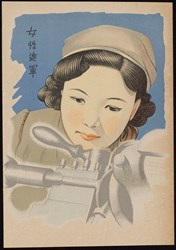 In June, 2022 we mounted a World War II exhibit at Washington University's Olin Library, Stories from World War II, focusing on the letters of Walter M. Goldschmidt, a German-born American who served under the Allies. Included in the exhibit was a selection of World War II concentration and internment camp money, loaned by Steve & Ray Feller, and a number of war bonds from the collection of Joe Boling. This material is now imaged and viewable on Newman Portal. Newman Portal acknowledges Steve & Ray Feller and Joe Boling for their contributions to this exhibit.
In June, 2022 we mounted a World War II exhibit at Washington University's Olin Library, Stories from World War II, focusing on the letters of Walter M. Goldschmidt, a German-born American who served under the Allies. Included in the exhibit was a selection of World War II concentration and internment camp money, loaned by Steve & Ray Feller, and a number of war bonds from the collection of Joe Boling. This material is now imaged and viewable on Newman Portal. Newman Portal acknowledges Steve & Ray Feller and Joe Boling for their contributions to this exhibit.
Image: Josei shingun poster (6x8.75") of Japanese female war worker, from the Joseph Boling collection
Link to World War II: Internment and Concentration Camp Money image collection on Newman Portal:
https://nnp.wustl.edu/library/imagecollection/517446
Link to World War II: War Bonds image collection on Newman Portal:
https://nnp.wustl.edu/library/imagecollection/517497
Link to Washington University Stories from WWII
(E-Sylum, June 26, 2022):
https://www.coinbooks.org/v25/esylum_v25n26a06.html
VIDEO: ROBERT W. JULIAN
The David Lisot Video Library on the Newman Numismatic Portal can be found at:
https://nnp.wustl.edu/library/multimediadetail/522852
We highlight one of his videos each week in The E-Sylum. Here's one from 1986 interviewing author and researcher Bob Julian. -Editor
ANA Numismatic Personality: Robert W. Julian David Lisot, Interviewer.
A member of ANA since 1957, he teaches high school mathematics. He had collected stamps initially, then moved to coins. He collects U.S. coins, and Imperial Russian coinage. and has traded with collectors in the Soviet Union and Europe. He started in research in the 1950 when corresponding with Dr. Spassky Began writing articles for Numismatic Scrapbook, visited the Smithsonian and the National Archives, and wrote a book on the medals of the U.S. Mint. -Editor
To watch the complete video, see:
https://nnp.wustl.edu/library/book/557356
NOTES FROM E-SYLUM READERS: JANUARY 29, 2023
Another Anti-King Engraved Coin
Jeff Rock writes:
"Sadly still a bit behind in my E-Sylum reading, but wanted to note that Joseph II of Belgium was not the only king not loved by his people, and with that sentiment engraved on a coin. This British evasion copper, struck around 1796-8, has poor Joseph's death on the gallows beat quite handily - George III has a noose around his neck, an arrow ready to pierce his chest and, for good measure, an axe ready to hit him in the forehead! While evasions didn't circulate in America (contrary to the opinion of some 19th century numismatists!), they did circulate in England and Ireland, and whoever engraved this one was clearly no fan of George!"
Great piece! Thanks. Here's the Joseph II piece we discussed earlier. -Editor
To read the earlier E-Sylum article, see:
NUMISMATIC NUGGETS: JANUARY 1, 2023 : Altered 1789 Coin: Joseph II on the Gallows
(https://www.coinbooks.org/v26/esylum_v26n01a21.html)
Coins Struck With False Dies
"I'm fairly certain that the 1964 cent from Tom Kays in last week's E-Sylum is not a real error. It has the look of a coin struck from false dies. You can see a 1955 example of mine at https://forums.collectors.com/discussion/911581/major-error-eye-candy-4-1955-double-date-lincoln-cent, and a bunch more when you search for "struck with false dies" or similar (some others: https://forums.collectors.com/search?adv=&search=false+dies)"
Thanks. Crazy coins! -Editor
To read the earlier E-Sylum article, see:
WAYNE'S NUMISMATIC DIARY: JANUARY 22, 2023
(https://www.coinbooks.org/v26/esylum_v26n04a17.html)
More on David W. Lange
David Gladfelter writes:
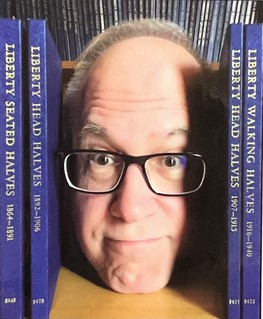 "I was unaware that David suffered from incurable cancer so news of his death was a shock. When attending coin shows (which I haven't done since the pandemic) I always looked for him on the floor, to exchange greetings if nothing else – the traffic kept him very busy. I have all 10 of his books, most of them inscribed because I collect people as well as coins. If you have an interest in coin collecting albums, there's nothing in print outside of his four books about them – I sent him info on at least one variety that had escaped his notice. He talked about publishing his 2020 Whitman book digitally because of the expense of doing a high-quality print version – fortunately he went ahead with the print version.
"I was unaware that David suffered from incurable cancer so news of his death was a shock. When attending coin shows (which I haven't done since the pandemic) I always looked for him on the floor, to exchange greetings if nothing else – the traffic kept him very busy. I have all 10 of his books, most of them inscribed because I collect people as well as coins. If you have an interest in coin collecting albums, there's nothing in print outside of his four books about them – I sent him info on at least one variety that had escaped his notice. He talked about publishing his 2020 Whitman book digitally because of the expense of doing a high-quality print version – fortunately he went ahead with the print version.
"My last communication with him was about the Coin and Currency Institute's U.S. coin catalogs and price lists from the 1960s. David was looking to collect these lists from each of the thirty-odd department stores where C&C had rare coin departments. I offered to trade him lists from the Gimbels-Schusters store in Milwaukee, one of them signed by Jack Friedberg, where I was then living. The lists of that store, he told me, are among the most common. This topic may have been for one of David's personal collections, or maybe for a future publication. We won't know."
Ray Czahor writes:
"I knew David quite well because of his strong interest in Philippine Numismatics. He had nice collections of coins and paper money. I ended up buying his paper money collection while visiting him at a Long Beach show back in late 1990's. HIs book on Mints published in 2005 is outstanding in depth if you can find it. It came out at the ANA show in San Francisco and I was able to purchase a copy to give to the Central Bank Director who came to the Philippine Collectors Forum and gave a comprehensive talk on the Central Bank Museum collection. That PCF meeting was one of our best as Ron Guth who was at PCGS at the time gave inside to grading standards talk.
"David will be sorely missed as he was an expert at NGC and could help us when we had an issue with grading Philippine coins there."
There was an amazing outpouring of thoughts on the event of Dave's death - it's a great loss to the hobby. -Editor
To read the earlier E-Sylum articles, see:
DAVID W. LANGE – RECOLLECTIONS
(https://www.coinbooks.org/v26/esylum_v26n04a12.html)
REMEMBERING DAVID W. LANGE (1958–2023)
(https://www.coinbooks.org/v26/esylum_v26n04a13.html)
Query: Woodward Sale #27 Supplement
Dave Hirt writes:
"I was looking through my W E Woodward auction catalogs, and found something curious to me in sale #27. Along with the sale, I have a supplement that duplicates lots 2861-2941, which had been printed in the sale catalog. This supplement was to be offered on the last day of the sale. They were Stone Implements Etc. In the 19th Century these stone implements had some connection with numismatics, but over the years seem to have lost that connection.
"My supplement is bound with my catalog. Do any of our readers have this supplement in their collection of Woodward catalogs?"
In the early days before hobby specialization, most collectors seemed to collect a little of everything, from stamps to coins to Indian artifacts and "curios" in general. Many early numismatic articles are found in philately and curio collecting publications, and many early coin dealers handled such items as well.
Can anyone shed some light on this supplement? -Editor
To read Woodward's 27th sale on the Newman Numismatic Portal, see:
https://nnp.wustl.edu/library/auctionlots?AucCoId=29&AuctionId=511204
Proof-10
Ken Spindler passed along this listing from the Stack's Bowers John McBride Collection. It's a rare cent with the quite unusual (low) grade Proof-10. -Editor
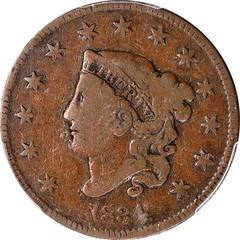 1834 Matron Head Cent. N-7. Rarity-7. Large 8, Stars and Reverse Letters. Proof-10 BN (PCGS).
1834 Matron Head Cent. N-7. Rarity-7. Large 8, Stars and Reverse Letters. Proof-10 BN (PCGS).
A legendary large cent rarity, the proof-only 1834 N-7 variety is the absolute key to a set of Matron Head cents by Newcomb number and there are just eight examples presently accounted for. To the best of our knowledge an example hasn't sold at auction since the Mervis Collection sale in January 2014. This piece is one of three well circulated examples known while the others are Mint State or nearly so.
To read the complete lot description, see:
1834 Matron Head Cent. N-7. Rarity-7. Large 8, Stars and Reverse Letters. Proof-10 BN (PCGS).
(https://auctions.stacksbowers.com/lots/view/3-10KA6Y/1834-matron-head-cent-n-7-rarity-7-large-8-stars-and-reverse-letters-proof-10-bn-pcgs)
THE BOOK BAZARRE
100 Greatestlibrary. Presented chronologically as a richly illustrated historical narrative of Canadian numismatics. 160 pages, coffee-table, hardcover. Order your copy online at Whitman.com , or call 1-800-546-2995.
ENGRAVER ALLEN LEONARD'S WEBSTER VASE
Heath White has been researching the career of engraver Allen Leonard, and he provided this chronicle of his work correcting a 180-year-old attribution error. Thanks! -Editor
I started researching Allen Leonard a few weeks ago because two of the dies in my collection were engraved by him. One of the articles I found that mentioned him was in Longacre's Ledger (found on NNP) and it was an excerpt from a book titled, "1849: The Mint Strikes Gold."
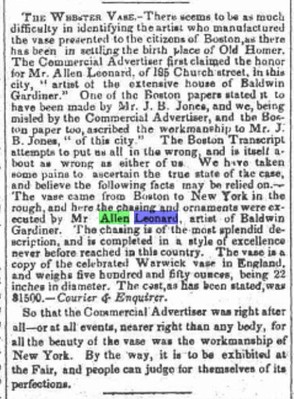 One thing that came up in my research was the Webster vase. The Webster vase was presented to Daniel Webster in Boston in 1835 and has been owned and displayed at the Boston Public Library since 1865. This vase has been written about in books and magazine articles and was one of the feature artifacts of at least two thesis papers I found. Essentially, it has been described as one of the finest examples of silver engraving executed in Boston. The problem I had was the engraving has been attributed to a Boston silversmith, Abadiah Rich, for the past 180 years or so and in my research on Leonard I found at least a half dozen contemporary newspaper articles that clearly stated Leonard engraved it. Turns out the finest example of silver engraving in Boston was actually executed by a Philadelphia silversmith living in New York, Allen Leonard.
One thing that came up in my research was the Webster vase. The Webster vase was presented to Daniel Webster in Boston in 1835 and has been owned and displayed at the Boston Public Library since 1865. This vase has been written about in books and magazine articles and was one of the feature artifacts of at least two thesis papers I found. Essentially, it has been described as one of the finest examples of silver engraving executed in Boston. The problem I had was the engraving has been attributed to a Boston silversmith, Abadiah Rich, for the past 180 years or so and in my research on Leonard I found at least a half dozen contemporary newspaper articles that clearly stated Leonard engraved it. Turns out the finest example of silver engraving in Boston was actually executed by a Philadelphia silversmith living in New York, Allen Leonard.
I've been trying to convince the Boston Public Library that Leonard engraved their vase and have provided them multiple contemporary sources that clearly state such.
With help from Wayne, Roger Burdette and Len Augsburger I found a letter on the Newman Portal that Allen Leonard wrote to Robert Patterson (director of U S Mint) on November 21, 1845. In this letter he references the Webster vase as an example of his work:
"...of the one made in 1834, presented to D. Webster by the merchants of Boston. worth the same amount, there can be no difficulty about this."
It seems I'm making progress on getting the provenance information corrected to give Allen Leonard credit for engraving the Webster Vase. This was sent to me from Jay Moschella, the curator of Boston Public Library's rare book & manuscript collection:
"This is excellent detective work and to me, it seems compelling. We will certainly update our cataloging information accordingly and will provide a succinct narrative of this attribution. It can take a while for change to percolate up into our digital repository, but it will be fixed in due course.
"Given the profile of the Webster Vase and the continued interest in its history, I hope you will consider publishing this information, which you have done so much to uncover!"
A 180-year mystery solved. Thanks for your dogged work! -Editor
For more on the Webster Vase, see:
Presentation vase in silver honoring Daniel Webster
(https://www.digitalcommonwealth.org/search/commonwealth:hq37wc485)
VOCABULARY TERM: MINT ERROR
Here's another entry from Dick Johnson's Encyclopedia of Coin and Medal Terminology. -Editor
Mint Error. A malformed piece produced at a mint. Mint error coins are those that are not perfect but which have been issued along with perfect, production run pieces. Any struck item which is an anomaly – and the number of things that can go wrong in coin and medal production is great – can be classed as a mint error. The term was formerly called freaks or fidos (for Freaks, Irregulars, Defects and Oddities); currently numismatic writers prefer mint error, error coins or even numismatic errors.
The many steps of planchet manufacture, striking and coining, all contribute to the existence of malformed blundered, accidental, mistaken struck pieces. The list of 79 different blanking and striking anomaly terms are included in this encyclopedia. However, other anomalies exist other than striking errors. These include one design error, four modeling and editing errors, sixteen die anomalies and errors, six metal anomalies, eight casting anomalies, four metalworking and heat treating anomalies, and seven finishing anomalies. See Chart.
Mint error collecting. This area of numismatics was a creation of the later half of the 20th century. Misstruck pieces in previous generations of numismatists were not considered highly collectible. They were tolerated but not venerated as they are today. Perhaps these malformed items became of numismatic interest with the increased interest in varieties. In effect, perhaps, a mint error was also considered a variety (more accurately, a subvariety).
After 1950 with the widespread interest in coin collecting, studying coins became more and more directed to smaller and smaller areas of a coin. Minute variations became collectible. Diebreaks, for example, were studied with intense interest. Articles and pamphlets were published, collectors of these banned together and formed clubs, some very specialized (like the filled die of the word Liberty only on U.S. Lincoln cents). These aficionados even created their own terminology; cud, railroad rim, saddle strike and many of the terms found in the adjacent chart were born.
A major benefit of this activity was the interest these collectors took in mint technology to explain how many of these error coins were made. The terms of interest to these collectors which found acceptance in the numismatic field are found in this book.
To read the complete entry on the Newman Numismatic Portal, see:
Mint Error
(https://nnp.wustl.edu/library/dictionarydetail/516320)
WHAT WAS THE FIRST JUNIOR COIN CLUB?
E-Sylum Feature Writer and American Numismatic Biographies author Pete Smith submitted this article on Junior Coin Clubs. Thanks! -Editor
This week I worked on revising the history for my local coin club, the Northwest Coin Club. I came across a clipping that claimed credit for formation of the first junior coin club. I wonder if that claim is correct.
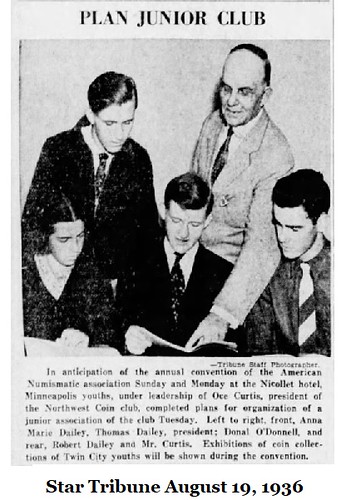 The Northwest Coin Club was organized in Minneapolis on February 10, 1934. Almost
immediately, the club applied for membership in the American Numismatic Association. General
Secretary Harry T. Wilson sent a card acknowledging the application on May 22, 1934. The club
became member #4517.
The Northwest Coin Club was organized in Minneapolis on February 10, 1934. Almost
immediately, the club applied for membership in the American Numismatic Association. General
Secretary Harry T. Wilson sent a card acknowledging the application on May 22, 1934. The club
became member #4517.
At the 1935 ANA Convention in Pittsburgh, invitations for the 1936 convention were presented by Detroit, Hartford, Philadelphia and Minneapolis. The infant Northwest Coin Club of Minneapolis was selected to host the 1936 convention.
The August 19, 1936, article in the Star Tribune reported on the formation of the first junior coin club in the United States. President of the senior club at the time was Oce Curtis, owner of the Curtis Hotel. He knew how to get his name and photo in the paper to promote the upcoming national convention.
It is interesting that three of the four junior members shown had the same last name. Robert
Dailey was the oldest son, Thomas was the middle child and Marie was the youngest. The
Minneapolis Junior Coin Club
installed an exhibit of foreign coins at the 1936 ANA
Convention.
I have not found any other reference to the Dailey family or the Minneapolis Junior Coin Club in the club archives after 1936. A new Minneapolis Junior Coin Club was admitted to the ANA as member 24645 in 1955. I have not found records for them either.
Was this a legitimate attempt to form a junior coin club or just a promotional stunt? I don't know. Is there any junior club that can claim an earlier beginning?
Great question! Can anyone tell us about other early Junior coin clubs? -Editor
THE CELINA COIN COMPANY
The Daily Standard of Celina, Ohio published a story about the local Celina Coin Co., its owners, and the ultrarare coins they handled. -Editor
One of the rarest and most famous U.S. gold coins ever made was once in the hands of two Celina businessmen.
John Sacher, a Celina attorney and coin expert, during the Western Ohio Civil War Roundtable on Thursday spoke about the $10 million 1870-S $3 gold coin, the coin's connection to Celina Coin Co. and its temporary owners Ted and Carl Brandts.
Of the more than 535,000 pieces issued, one $3 gold piece sticks out above the rest - the 1870-S, Sacher said.
In 1870, the newly-built second San Francisco Mint was opened, according to the American Numismatic Association (ANA). Numismatics is the study or collection of currency. To commemorate the occasion, a set of San Francisco coins were made to place into the cornerstone of the new mint building, per the ANA.
However, three denominations were not being made by the San Francisco Mint in 1870: the half dime, the dollar and the $3 gold piece. These pieces were struck for this ceremony, according to the ANA.
The superintendent of the San Francisco Mint indicated that only a single piece had been struck to be put in the cornerstone of the building, according to PCGS.
Yet a specimen appeared in the William H. Woodin sale in 1911, which was claimed to be a duplicate of the coin in the cornerstone. Sacher said some believe a coin is still located in the cornerstone, while PCGS speculated the two coins are one in the same.
All the same, the coin has a known pedigree, has been circulated many times and has visible imperfections, Sacher said.
The numbers "893" were scratched upside down above the wreath on the back of the coin, he noted. There's also indications the coin had been used as jewelry due to its pebbled appearance, per PCGS.
The former Mercelina Park Hotel was once owned by the Brandts family. A safe on the second floor of the hotel housed rare and valuable coins.
Despite its blemishes, the lone piece came into the hands of Ted and Carl Brandts, owners of the Celina Coin Co., in the 1940s, Sacher said. The Brandts were also the owners of the Mercelina Park Hotel, he added.
"The Celina Ohio Coin Company, they did national business of rare coins," Sacher said. "They had inventory with a printout sheet, they consigned stuff to auction, and they were in the business until the mid- to late-40s."
At the same time the Brandts owned the valuable $3 gold piece, they also owned two other exceedingly rare coins, Sacher said. That included an 1885 trade dollar, five of which are known to exist and worth about $10 million a piece today, and an 1884 trade dollar, 10 of which are known to exist and worth about $3 million each, he said.
"They had three coins in their inventory at one time that there's one known, five known and 10 known, to this day. None have been discovered since that time," Sacher said. "All (kept) in the safe on the second floor of the Mercelina Hotel near Mercelina Park."
The Brandts sold the $3 gold coin in 1945 for $11,500. The coin is now worth over $10 million, he said.
"Every time one of those three pieces I described is sold, Celina, Ohio gets some press, and the Brandts brothers," he added.
Can anyone tell us more about the Celina Ohio Coin Company and the owners Ted and Carl Brandts? -Editor
To read the complete article, see:
Rare coin was once in Celina
(https://www.dailystandard.com/archive/2023-01-28/stories/46986/rare-coin-was-once-in-celina)
ATLAS NUMISMATICS JANUARY 2023 UPDATE
Atlas Numismatics has updated their website with 595 new coins, medals, and tokens at fixed prices. Selections include the following items. Nice coins (and a medal)! -Editor
1073132 | GREEK. THESSALY. Larissa. Struck 4th Century BC. AR Drachm. NGC Ch. XF? (Choice Extremely Fine ?) Strike 5/5 Surface 4/5 Fine Style. 6.12gm. Head of the nymph Larissa facing slightly left with ampyx in her hair / ????S / ??O?. Grazing horse to right. Herrmann cf. Table. V, 5; Lorber in SNR 79 Phase L-III; cf. BCD 316ff.
Ex-Münzen & Medaillen Fixed Price List 420, Basel 1980, Nr. 10. $5,950
To read the complete item description, see:
https://atlasnumismatics.com/1073132/
1073610 | AUSTRIA. Maria Theresa. "1780" (c.1950) S•F• AV Restrike Taler (20 Ducat). PCGS MS62. Private Swiss mint. Edge: Plain. 73.45gm. Bust of Maria Theresa, right; signed S.G. below truncation / Imperial Eagle. KM-T2; Hafner II.: 77b.
Krause reports this issue was struck for Haile Selassie (Emperor of Ethiopia, 1930-1974). From a mintage of just 200 pieces. $11,500
To read the complete item description, see:
https://atlasnumismatics.com/1073610/
1073718 | FRANCE. Aquitaine. Edward the Black Prince. (Prince of Aquitaine, 1362- 1372).(1362-72) ND-B AV Pavillon d'Or (Noble Guyennois a I'E). NGC MS64. Bordeaux mint. 4.81gm. ?D : PO : GnS : R?GI AnGL : PnCS : AQI. Duke holding sword and standing under a gothic canopy with two lions at his feet and two ostrich plumes to either side / + DnS : AIVTO : Z : PT?CIO : m? : Z : IIPO : SPAVIT : B.
Foliate cross in quatrefoil over a quadrangle, E at center with two leopards and two lis in the angles. Duplessy 1120A; Friedberg 5.
Ex. Fernand David Collection. $26,950
To read the complete item description, see:
https://atlasnumismatics.com/1073718/
1070246 | FRANCE. 2nd Republic. (1848-1852). 1848 Tin Essai 5 Francs. PCGS SP65. By Rogat. Paris. Edge: Plain. 17.30gm. Laureate head, left / Value within wreath. KM Pn65; Mazard 1297c/R. $985
To read the complete item description, see:
https://atlasnumismatics.com/1070246/
1072144 | GERMANY - EMPIRE. Wilhelm II. (German Emperor, King of Prussia, 1888–1918). 1914 AR Medal. PCGS SP64. By A. Hummel. Edge: 990. 33.4mm. 15.09gm. Nude warrior holding a war flag and sword standing next to a fallen man lying on the ground / Six-line inscription within oak wreath. Zetzmann 4060.
Struck to commemorate the heros of Siege of Tsingtau. $1,495
To read the complete item description, see:
https://atlasnumismatics.com/1072144/
1073037 | GREAT BRITAIN. Anne. (Queen, 1702-1714). 1713 AV Five Guineas. NGC AU58. ANNA · DEI · - GRATIA ·. Last bust left / MAG - BRI · FR - ET · HIB - REG ·. Crowned shields in cruciform, sceptres at angles. KM 535; SCBC-3568; ESG- 452 (Bull); Fr.-317.
Lovely lustrous surfaces. $125,000
To read the complete item description, see:
https://atlasnumismatics.com/1073037/
1071829 | GREAT BRITAIN. Wales, Anglesey. 1787 CU Penny Token. PCGS MS64BN (Brown). Edge: ON DEMAND IN LONDON, LIVERPOOL OR ANGLESEY. Druid's head encircled by wreath, four acorns at tie / WE PROMISE TO PAY THE BEARER ONE PENNY •. PM CO Cypher. D&H 30 Thick wreath. $349
To read the complete item description, see:
https://atlasnumismatics.com/1071829/
1073038 | GREAT BRITAIN. George III. (King, 1760-1820). 1816 AV Pattern Sovereign. NGC PR64 Cameo. By Thomas Wyon Jr. after Pistrucci. London. Edge: Plain. 8.17gm. Large laureate bust / Crowned ornate square-top shield of arms. W&R- 185 (R6, 3-5 examples known).
Superb original surfaces, exceedingly rare. Reverse die cracks (as evident in Wilson & Rasmussen plates for W&R-185 and W&R-186). $79,500
To read the complete item description, see:
https://atlasnumismatics.com/1073038/
1073623 | MADAGASCAR. Ranavalona III. (Queen, 1883-1897). 1895 AR Dollar. PCGS PR62. RANAVALO MANJUKA 3. Crowned, veiled portrait of the Queen /RAMODOMAMDRIANIMPOINIMERINA (rose) MADAGASCAR (horse). Crowned heart over the petals of the Royal Poinciana (national flower)with large "R" dividing date. Lecompte 37 argent.
Just 25 pieces minted.
Ex-Heritage World Coin Auctions, CICF Signature Sale 3046, Auction 14 (April 2016), Lot number 30299 ($12,000). $11,500
To read the complete item description, see:
https://atlasnumismatics.com/1073623/
1072888 | SPAIN. Ferdinand and Isabella. (King and Queen, 1475-1504). (1476-1516)- A (Aqueduct) AV 4 Excelentes. PCGS MS62. Segovia. 14.04gm. +F?RnAnDuS: ?T • h?LISAB?T: D: G: R?X: ?T: R?GInA:. Crowned facing busts of Ferdinand and Isabella, aqueduct above, A to right, annulet O over IIII below / SVB: VnBRA: ALARVm: TVARVm: PROT?G?: nO:. Crowned royal shield over nimbate eagle. Calico 770; Fr.-125. $115,000
To read the complete item description, see:
https://atlasnumismatics.com/1072888/
Updates to their online inventory are issued monthly. For more information and to sign up for the firm's monthly newsletter, visit: atlasnumismatics.com
LONGACRE HARD WAX MODELS OFFERED
In their upcoming February 2023 Long Beach Expo sale, Heritage is offering an amazing piece of U.S. numismatic history - two original hard wax models created by engraver James Longacre for gold coinage. -Editor
Original Wax Engravings on Copper Disks. This renowned, framed set of original James B. Longacre wax models is both aesthetically pleasing and numismatically important. Intricately rendered by Longacre's hand, the wax models represent an early step in the mid-1850s die making process, where they were critical to both the creative design and the successful completion of satisfactory steel hubs. Longacre was a deliberate engraver and always meticulous in his work. The wax models allowed him to finalize his initial sketches, creating three-dimensional wax motifs that were several inches in diameter -- much larger than their final size, and an essential requirement for ease in workmanship.
Once the wax models were complete, they were cast in plaster. The hardened plaster casts served as molds, into which molten metal was poured to create a usable copy of the original artwork. The metal copies were a necessary step before being transferred the Contamin portrait lathe for reduction and eventual preparation of a steel master die.
The Indian Princess portrait and the Agricultural Wreath designs were Longacre's contributions not only to the three dollar gold piece in 1854, but also to the redesigned gold dollar. Type Two gold dollars feature the Agricultural Wreath reverse, which was then carried over to Type Three gold dollars employing Longacre's Indian Princess obverse (in use from 1856 through the series end in 1889). The elegant Agricultural Wreath also appears on Flying Eagle cents dated 1856 through 1858. Rick Snow once owned these models, later purchased from him by Tom Bender via Brian Wagner.
These wax enlargements are preserved an attractive, well-made wooden frame measuring 13 3/8" wide x 8 3/8" tall x 1 7/8" deep. A thick, cream-colored matte surrounds the wax models with circular, beveled openings, each measuring 3 5/8" in diameter. The wax engravings sit on heavy copper disks, each securely supported by the custom frame. These Longacre wax models may or may not have been used to create iron castings for the reducing lathe. They are plated on page 31 of United States $3 Gold Pieces 1854-1889 by Q. David Bowers with Douglas Winter. The Agricultural Wreath model is plated in Rick Snow's The Flying Eagle & Indian Cent Attribution Guide (3rd edition, Volume I) on page 22.
To read the complete lot description, see:
Two Hard Wax Models
Prepared by James B. Longacre
The Indian Princess and Agricultural Wreath
(https://coins.ha.com/itm/three-dollar-gold-pieces/three-and-four-dollar-gold/original-wax-engravings-on-copper-disks-pcgs-8017-/a/1357-3669.s)
WORLD BANKNOTE AUCTIONS US SALE 1
Here's the press release for World Banknote Auctions' first U.S. currency sale. -Editor
World Banknote Auctions is excited to announce its upcoming US Currency Sale 1, featuring a wide range of rare and collectible banknotes from the United States. The auction will take place on February 24 on the firm's website and will feature notes from the colonial era to modern times, including scarce large-size notes, fractional currency, and error notes.
Highlights of the sale include a rare 1934 $5000 Federal Reserve Note from the Dallas District graded PMG Choice Uncirculated 64, a unique 12-piece 1999 $10 district set with Solid Serial Number 9 and a PMG Choice Uncirculated 64 EPQ 1869 $5 Legal Tender Note. These notes are highly sought after by collectors and investors and are expected to fetch significant prices at auction.
In addition to the rare notes, the sale will also feature a selection of more affordable notes for the budget-conscious collector. These notes are a great opportunity for novice collectors to start building their collection or for experienced collectors to add to their existing collection. The auction will be held online and will be open for bidding to the public.
World Banknote Auctions has also listed part 1 of the Navy Commander Collection of U.S. National and Gold Banknotes, which will take place on March 10. This collection features a wide variety of National and Gold Banknotes from the late 19th and early 20th century. The focus is on California banks, but the sale also includes select key notes from around the country. Highlights include a $10 Gold Note from the First National Bank of Oakland, CA graded Fine 12 by PMG, an 1882 $50 Date Back on the Citizens National Bank of Los Angeles, CA graded Very Fine 25 by PMG and only the third mismatched prefix on a National Banknote, a 1929 Type 1 $10 on the First National Bank of Boston, MA, graded Very Fine 25 by PMG. This collection is a treasure trove of banknote history that will appeal to collectors and investors alike. Both auctions will be held online and both catalogs have been posted for immediate viewing and bidding. A printed catalog has been prepared for the Navy Commander Collection and is available from the company by request.
About World Banknote Auctions: Headquartered in Sacramento, California, World Banknote Auctions was founded by Dennis Hengeveld. The firm specializes in auctions of US & World Paper Money held regularly on its website, www.worldbanknoteauctions.com.
Lot 1146 is an interesting matched set of 1999 Federal Reserve Notes. Here's the lot description. -Editor
1999 Fr. 2033 PMG Graded Set of (12) 10 Dollar Federal Reserve Notes With Matching Solid #9 S/N
Unique Set of 12 Solid S/N 9's on 1999 $10 District Set
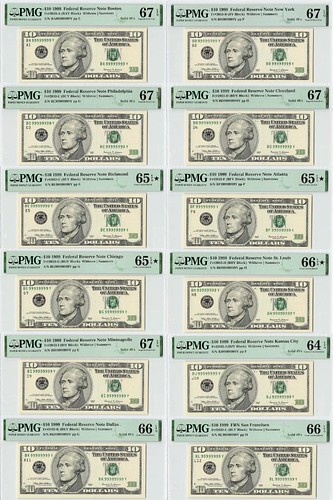 This offering does not only represent twelve of the single rarest solid serial number on United States notes, those twelve notes are also the only solid #9's currently known to have been printed for this design. An extremely rare opportunity for the fancy serial number specialist and one that we can truthfully say will not be repeated anytime soon, if ever.
This offering does not only represent twelve of the single rarest solid serial number on United States notes, those twelve notes are also the only solid #9's currently known to have been printed for this design. An extremely rare opportunity for the fancy serial number specialist and one that we can truthfully say will not be repeated anytime soon, if ever.
The rarity of solid serial number 9's, especially on modern Federal Reserve Notes, perhaps needs some explanation. After the 1974 series the Bureau of Engraving and Printing adopted a policy where it stops each print run at 96 million. Serial numbers above this are reserved for collector items, such as uncut sheets, or special sets. This is why an "error" on a modern note can easily be identified as homemade if it has a serial number starting with 99, as it means that it was cut by hand from an uncut sheet by someone in his garage and is not a genuine error.
Very rarely does the BEP release solid serial number 9 notes, which has contributed to its great rarity today. Most solid serial #9's that appear on the market today are $1s dated prior to 1974. Seldom does one appear that is dated after, and any denomination besides $1 or $2 is extremely rare. In fact, according to BEP, no modern solid #9's have ever been released for the $5, $20, $50 or $100 denominations, and there are only 26 modern solid #9's in existence in total. Twelve of those are offered in this lot.
The existence of this set of twelve notes, one for each Federal Reserve District is due to a special set produced by the BEP with matching serial numbers made when the "Big Head" design on the $10 was introduced in 2000. 2,000 matching serial number sets were produced of the last "Small Head" design (Series 1995) and 2,000 sets of the new design seen here. The serial numbers for each set started at 99997999, meaning that the very last set of each had the coveted solid serial number 9. This design was replaced by an updated version in 2006, but no other solid number 9's have been produced for this denomination since. As such, these twelve notes are the only solid serial number 9's ever printed for this design.
We must note that the Series 1995 solid number 9 set was sold most recently elsewhere in 2022 for $118,800. Those were of the previous design, of which a few other solid number 9's dated prior to 1974 exist. Virtually all of those notes were severely off-center and only a few came even close to a Gem Uncirculated grade. In contrast, all but one of the notes offered in this set are graded at least Gem Uncirculated by PMG, and several have received the coveted "Star" designation for exceptional eye-appeal. An incredible opportunity not to be missed. It must also be noted that no other modern Solid #9's have ever been graded Superb Gem Uncirculated, so the five included in this set are the finest grades for this iconic serial number, of any modern US note, regardless of design or denomination.
To read the complete lot description, see:
1999 Fr. 2033 PMG Graded Set of (12) 10 Dollar Federal Reserve Notes With Matching Solid #9 S/N
(https://bid.worldbanknoteauctions.com/lots/view/4-8N2THN/1999-fr-2033-pmg-graded-set-of-12-10-dollar-federal-reserve-notes-with-matching-solid-9-sn)
NUMISMATIC AUCTIONS SALE 67 WORLD HIGHLIGHTS
Here are some highlights from Auction 67 Session II from Numismatic Auctions LLC. -Editor
Lot 565: Albania. Prova 5 Franga Ari, 1927-V. As KM-Pr22 yet a 22.8g collector copy/restrike. Beautiful violet, blue and golden toned mirror Proof. An affordable and stunning high grade space filler and study piece to help educate the collector of this series from mistaking one like this as an original. ($100+)
To read the complete lot description, see:
Albania Prova 5 Franga Ari, 1927-V Collector Restrike Violet, Blue & Golden Toned Mirror Proof
(https://numismaticauctions.nextlot.com/auctions/1421161/lots/11558527)
Lot 579: Austria 2 Taler, ND(c.1658-1705).Hall. Dav. 3249, KM-1119.2. Choice VF/EF, obverse a tad bright, lt tooling with toning in devices, an apparant old mount removal yet still a pleasing Leopold the Hogmouth Double Taler. Ex: Emporium Hamburg with ticket. ($500-750)
To read the complete lot description, see:
Austria Leopold the Hogmouth Double Taler Dav 3249 VF/EF Ex: Emporium Hamburg
(https://numismaticauctions.nextlot.com/auctions/1421161/lots/11558625)
Lot 581: Austrian States, Salzburg Klippe ½ Turmtaler, ND(1587-1612). Probst-810. Toned About EF to EF, mount removal and tooling at 12 o'clock. Rare type. ($200-300)
To read the complete lot description, see:
Austrian States, Salzburg Klippe 1/2 Turmtaler c. 1587 About EF to EF Rare Type
(https://numismaticauctions.nextlot.com/auctions/1421161/lots/11558639)
Lot 604: British Honduras Cent, 1885. KM-6. Red Unc to Choice Unc with an almost Prooflike appearance, a few stray marks and tiny flecks reverse keep this from a higher grade. ($150-200)
To read the complete lot description, see:
British Honduras Cent 1885 Red Unc to Choice Unc
(https://numismaticauctions.nextlot.com/auctions/1421161/lots/11558800)
Lot 632: China, Fengtein Dragon Dollar, Yr. 24(1898). Y-87. Gunmetal toned EF. ($750-1000)
To read the complete lot description, see:
China, Fengtein Dragon Dollar, Yr24(1898) Gunmetal toned EF
(https://numismaticauctions.nextlot.com/auctions/1421161/lots/11558996)
Lot 667: China, Yunnan Republic 1 Tael, ND(1943), struck in French Indo-China. KM-A2a, L&M-433. Amber to iridescent teal and cobalt blue toned lustrous Unc or virtually so, a few scattered lt marks. Popular issue and color to please. ($750-1000)
To read the complete lot description, see:
China, Yunnan Republic 1 Tael ND(1943) Struck in FIC Colorful & Lustrous Unc
(https://numismaticauctions.nextlot.com/auctions/1421161/lots/11559241)
Lot 676: Republic of China Yuan Shih-kai Plumed Hat Dollar, ND(1914). L&M-858, Y-322. Lustrous Unc, a few ever so faint lines and tiny ticks from Choice and an entirely appealing example with hints of color at borders and flashy centers. Perhaps ever so ltly dipped or wiped at one point long ago but now with handsome peripheral amber hues developing. A nice high grade specimen of this always popular type. Ex: PCI MS60 with tag. ($7500-10,000)
To read the complete lot description, see:
Republic of China Yuan Shih-kai Plumed Hat Dollar ND(1914) Lustrous Unc! Rare!
(https://numismaticauctions.nextlot.com/auctions/1421161/lots/11559304)
Lot 690: Republic of China Sun Yat-sen Junk Dollar, Yr.23(1934). L&M-110, Y-345. Choice original golden toned Unc, sharp with handsome luster. Ex: Harlan Berk and virtually Gem quality. ($200-300)
To read the complete lot description, see:
Republic of China Sun Yat-sen Junk Dollar Yr23(1934) Choice original toned Unc
(https://numismaticauctions.nextlot.com/auctions/1421161/lots/11559402)
To read the earlier E-Sylum articles, see:
NUMISMATIC AUCTIONS SALE 67 U.S. HIGHLIGHTS
(https://www.coinbooks.org/v25/esylum_v25n52a17.html)
NUMISMATIC AUCTIONS SALE 67 HIGHLIGHTS
(https://www.coinbooks.org/v26/club_nbs_esylum_v26n03.html#article19)
NUMISMATIC AUCTIONS SALE 67 U.S. HIGHLIGHTS
(https://www.coinbooks.org/v26/esylum_v26n04a15.html)
DAVISSONS AUCTION 42 ANNOUNCED
In an email to clients this week, Allan Davisson announced his firm's upcoming auction sale. -Editor
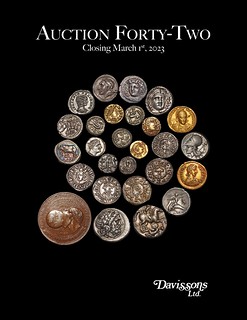 Auction 42, closing Wednesday, March 1st 2023, is online now! Print copies are being sent next week, if you are not on our mailing list and would like a copy please let us know.
Auction 42, closing Wednesday, March 1st 2023, is online now! Print copies are being sent next week, if you are not on our mailing list and would like a copy please let us know.
The fifty-five Anglo-Saxon lots in this sale represent a major offering in this series, and are the heart of the collection formed by Patrick Zabel, a committed and scholarly collector who was active in the latter part of the 20th century. That was a time when metal detectors were bringing finds to the market helping to make this historic series accessible to a broader range of collectors than had been possible a few decades earlier. The pieces offered here include three gold thrymsas, an impressive run of high grade and rare sceats, as well as pennies representing twenty-four different rulers or issuers of Anglo-Saxon pennies.
I knew Pat Zabel from many telephone conversations and from meeting him in person during trips through Texas with a small cohort of fellow professional numismatists in the 1990s. Pat was a dedicated collector with a strong scientific background, a good eye for quality and a broad range of numismatic interests. He sought quality in all his purchases and our invoices from that era show that some of the best coins we handled went to him. His Anglo-Saxon collection was his most significant area of interest but he was fascinated by other areas too. Living little more than a couple of hours from Mexico on Interstate 35, he also had an interest in Spanish American coins. Several pieces in this auction continue our presentation of that part of his collection, featured in our last e-auction. His interest in Spanish issues carried over into Ancient Greece in the form of Punic Spain and North Africa.
Two other areas that fascinated him were collections where individual pieces are typically worth very small amounts— barbarous radiates
of 4th and 5th century Britain and the Continent (Lot 228) and Russian wire money from 16th century Russia through 1717 during the reign of Peter the Great (Lot 381). (Marnie worked with him on forming both these collections over twenty years ago.) These collections are both composed of creative answers by societies in times of chaos to serve their need for small change. They also reflect the same dedication and attention to high quality that Pat exhibited with his Anglo-Saxon. Both collections are offered en bloc at estimates that represent less than one would have to spend to duplicate the collections piece by piece.
There is much more in this sale. It begins with gold from several consignors at a time when the price of gold is climbing. The sale opens with several important Roman Imperial issues including a particularly rare solidus of Julian II with sale prices for the very few other examples offered in recent years extending well into five figures. Rare medieval issues from the Zabel collection fit well with the Anglo-Saxon offering that we feature in this sale. There are also several high- quality modern gold pieces including Central American, Mexican, Turkish and US gold.
Responsibility for the ancient coinage we handle is now in the expert hands of Marnie and Lief. When I reviewed the ancient Greek silver I was amazed at the extent and quality of the section. Many of the better Greek pieces come from a consignment from another collector we have known for many years. His knowledge and sense of quality shines through in the material he consigned. Pat Zabel is again represented here by his collecting interest in the fascinating ancient coinage of North Africa, including issues from the First and Second Punic Wars and the family of Hannibal Barca (look for war elephants and horses).
The Roman section is also strong. It begins with lovely Roman Republican coins, all carefully selected fascinating types notable for their fresh surfaces and beautiful iridescent toning, many from a group that Marnie found. Also included are some beautiful imperatorial issues, the dictator Sulla and the Ptolemies, and Octavian and Mark Antony. First and Second Century Rome is well represented, many of the coins coming from a serious collection Lief handled purchasing that we bought early last year. Look for many rarities in both silver and bronze, including some amazing condition rarities, a group of denarii from the emperor Hadrian's Travel Series,
and much more.
Our catalogs have been offering 18th century provincial tokens (Conders
) from the beginning. This catalog is no exception. Three years ago I purchased a major collection of pieces based on R. C. Bell's Commercial Coins from a collector I have known for many years who has an excellent eye for quality. As he formed most of his collection in the 1970's and 1980's, in addition to D&H numbers, he also provided Bell numbers or GTT
from Waters for pieces that Arthur Waters deemed General Trade Tokens
in his 1954 publication Notes on Eighteenth Century Tokens. Look for some amazing pieces. (Jon Lusk has a recent publication on these same pieces—well worth owning.)
Variety comes in the form of a few European talers in exceptional condition from the Zabel collection, several important Spanish American coins, a few choice crown size pieces, and finally a few United States issues including a consigned run of choice Carson City dollars that have been recently graded by PCGS.
The penultimate portion of the auction harks back to 19th century United States with a couple of slavery-related pieces, some rarely seen Civil War related pieces, and an attractive encased US postage stamp. Finally, the last lot is one more side interest from Pat Zabel's collection—a small group of attractive porcelain coins.
Most of the material offered in this catalog is from collections carefully formed by knowledgable collectors.
As catalogers and dealers, we recognize quality when we see it and value the work of these passionate collectors. We hope you enjoy the result in this offering.
To browse the online and print catalogs, see:
https://davcoin.com/sale/Printed%20Auction%2042
https://davcoin.com/pdf-viewer/43873
NUMISMATIC NUGGETS: JANUARY 29, 2023
Here's a selection of interesting or unusual items I came across in the marketplace this week. Tell us what you think of some of these. -Editor
Iran. Zand. Karim Khan (AH 1166-1193/ 1753-1779 AD). Gold Mohur, Dar al-Sultana Isfahan AH 1169. 10.8 gm. Zand couplet, rev. Mint, epithet and date within fancy cartouche with four outer fleurs. The superb strike and rarity of this type suggests that it was intended mainly for donative purposes. A.2787. Extremely rare, especially as most of the known examples of this type are from the mint of Shiraz. Choice Extremely Fine.
Interesting, attractive piece. I don;t believe I've seen one of these before. From the SPINK January 30, 2023 auction. -Editor
To read the complete lot description, see:
IRAN. ZAND. KARIM KHAN (AH 1166-1193/ 1753-1779 AD). GOLD MOHUR, DAR AL-SULTANA ISFAHAN AH 116...
(https://live.spink.com/lots/view/4-8LJRU9/iran-zand-karim-khan-ah-1166-1193-1753-1779-ad-gold-mohur-dar-al-sultana-isfahan-ah-116)
Mexico 1761-Mo M 2 Reales NGC MS64 Color $5,950 New Sharply struck and exhibiting a rather pleasing patina. Rarely seen in such a lofty grade. A true condition census piece - total pop across both services is six with two finer, and it's quite possible one or more could be a resubmission.
Great piece from the online stock of Northeast Numismatics. -Editor
To read the complete lot description, see:
Mexico 1761-Mo M 2 Reales NGC MS64 Color $5,950 New
(https://www.northeastcoin.com/servlet/v?itemKey=zi29_1000278611)
Lot 4: Encased Good Luck 1902 Indian Cent. Greg Wright Medals, Badges, etc. Longworth Street, Cincinnati Ohio. Fantastic piece.
Nice encased item. It sold earlier this week. -Editor
To read the complete lot description, see:
Lot 4: Encased Good Luck 1902 Indian Cent. Greg Wright Medals, Badges, etc. Longworth Street, Cincinnati Ohio. Fantastic piece.
(https://www.invaluable.com/auction-lot/Encased-Good-Luck-1902-Indian-Cent.-Greg-Wright-4-c-B954AEB8DF)
1939 World War II DEFENSE OF FINLAND bronze 97mm by Delannoy
Fron the eBay stock of Hedley Betts. -Editor
To read the complete lot description, see:
1939 World War II DEFENSE OF FINLAND bronze 97mm by Delannoy
(https://www.ebay.com/itm/155368044065)
Bronze casting medal 1945, in the occasion of the end of the Second World War. Extremely fine. Estimate: 500 euros
An interesting Goetz medal in the upcoming KüNKER eLive Auction 76. -Editor
To read the complete lot description, see:
Bronzegußmedaille 1945, Kienast 608.
(https://www.kuenker.de/en/elive-auction/stueck/358917)
The Celluloid Starch Co. Token Grades xf+. Advertising merchant token issued by the Celluloid Starch Co., New Haven, Connecticut.
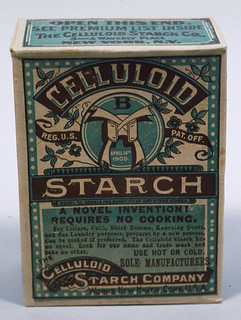
I've never heard of "Celluloid Starch" but this token prompted my curiosity. Here's an image of the product from the National Museum of American History. -Editor
To read the museum's database entry, see:
Celluloid Starch
(https://americanhistory.si.edu/collections/
search/object/nmah_333635)
To read the complete lot description, see:
The Celluloid Starch Co. Token Grades xf+
(https://www.liveauctioneers.com/item/145425611_the-celluloid-starch-co-token-grades-xf)
SOUTH KOREA'S NEW ROCKET COINS
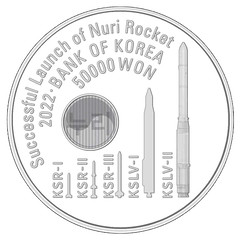
Author Mark Lovmo passed along this information about South Korea's new rocket coins. Thanks. Here's the common reverse. -Editor
South Korea has issued new coins to commemorate the successful launch of the country's first domestically built space rocket on June 21, 2022.
2,000 of each coin will be sold as single coins, and 5,000 of each coin will be included in 2-coin sets. The clear-plastic set packaging will resemble the nosecone of a rocket.
Information and images from the Bank of Korea's English webpage (Press Releases):
Issuance of Successful launch of the Nuri space rocket Commemorative Coins
Mark adds:
"North Korea gets all the attention in our media in regard to its rockets, but South Korea has rockets as well. ...and they are likely infinitely more capable than those of the DPRK!"
To read an earlier E-Sylum article, see:
NEW BOOK: SOUTH KOREAN COINS
(https://www.coinbooks.org/v25/esylum_v25n19a03.html)
THE MYTHICAL TRILLION-DOLLAR COIN
The idea of a trillion-dollar coin has popped up again as the U.S. Congress opens another amusing-not-amusing Kabuki theater debt-ceiling dance. Aaron Oppenheim passed along this article. -Editor
As the debt ceiling debate takes over the headlines in the U.S., so is the idea of minting a $1 trillion platinum coin, which is a surprising option available to the Treasury Department to raise the debt ceiling without bipartisan support.
The #MintTheCoin plan is gaining traction in some circles again as a deeply divided Congress makes the debt ceiling debate extra difficult, with fierce arguments on both sides of the aisle around debt, inflation, and the path forward.
The Treasury Department already began some extraordinary measures to keep paying the government's bills last week, including suspending investments for selected government accounts.
In a letter to Congress, Treasury Secretary Janet Yellen warned that there is "considerable uncertainty" around how long these extraordinary measures could be effective.
"I respectfully urge Congress to act promptly to protect the full faith and credit of the United States," Yellen said in the letter sent last week.
On the $1 trillion platinum coin loophole, which potentially allows the Treasury Department to mint platinum coins of any denomination and deposit them at the Federal Reserve in exchange for the U.S. federal debt, Yellen was very skeptical.
In an interview with The Wall Street Journal, Yellen said that the Federal Reserve is unlikely to agree to such a plan, calling the scheme a "gimmick."
"It truly is not by any means to be taken as a given that the Fed would do it, and I think especially with something that's a gimmick," she said in an interview published Sunday. "The Fed is not required to accept it, there's no requirement on the part of the Fed. It's up to them what to do."
The minting of a $1 trillion platinum coin loophole is in the law that dictates the mintage of coins. The exact wording can be found in the subsection (k) of 31 USC 5112, which governs "Denominations, specifications, and design of coins."
The clause states: "The Secretary may mint and issue platinum bullion coins and proof platinum coins in accordance with such specifications, designs, varieties, quantities, denominations, and inscriptions as the Secretary, in the Secretary's discretion, may prescribe from time to time."
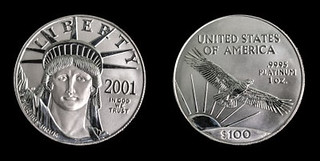 Theoretically, U.S. Treasury Secretary Janet Yellen can order the platinum coin to be minted and avoid a government shutdown if the debt ceiling is not raised in time.
Theoretically, U.S. Treasury Secretary Janet Yellen can order the platinum coin to be minted and avoid a government shutdown if the debt ceiling is not raised in time.
Important to keep in mind that the coin doesn't technically have to be made out of $1 trillion worth of platinum. It would require some platinum to be used, but it can be as small as a dime, with the U.S. Treasury assigning any value to it, including $1 trillion or even more.
To read the complete article, see:
Idea of minting $1 trillion platinum coin to avoid U.S. default is back and Yellen weighs in
(https://www.kitco.com/news/2023-01-24/Idea-of-minting-1-trillion-platinum-coin-to-avoid-U-S-default-is-back-and-Yellen-weighs-in.html)
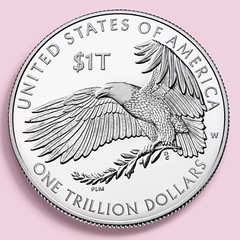 To read other articles on the topic (some subscriptions required), see:
To read other articles on the topic (some subscriptions required), see:
If the U.S. can't borrow more money, why not just mint a coin to fund the government?
(https://www.npr.org/2023/01/27/1152140597/if-the-u-s-cant-borrow-more-money-why-not-just-mint-a-coin-to-fund-the-governmen)
Janet Yellen Dismisses Minting $1 Trillion Coin to Avoid Default
(https://www.wsj.com/articles/janet-yellen-dismisses-minting-1-trillion-coin-to-avoid-default-11674417541)
The Trillion-Dollar Coin Might Be the Least Bad Option
(https://www.theatlantic.com/ideas/archive/2023/01/congress-debt-ceiling-trillion-dollar-coin-us-mint/672814/)
The trillion dollar coin debate is back. Experts explain if it can actually resolve the debt-ceiling crisis
(https://fortune.com/crypto/2023/01/23/can-the-us-invent-a-digital-trillion-dollar-coin-to-save-itself-from-default/)
To read earlier E-Sylum articles, see:
FORMER U.S. MINT DIRECTOR MOY ON THE TRILLION DOLLAR COIN
(https://www.coinbooks.org/esylum_v16n02a22.html)
FIRM MARKETS FANTASY TRILLION DOLLAR COIN
(https://www.coinbooks.org/esylum_v16n09a18.html)
MORE ON THAT TRILLION-DOLLAR COIN
(https://www.coinbooks.org/v20/esylum_v20n04a33.html)
TRILLION-DOLLAR COIN SILLY SEASON AGAIN
(https://www.coinbooks.org/v24/esylum_v24n40a24.html)
OKLAHOMA SENATOR PROMOTES BULLION IDEA
Meanwhile, some state legislatures continue to dabble with the idea of bullion-based exchange. -Editor
A bill filed in the Oklahoma Senate would establish a state bullion depository. This would not only create a safe place to store precious metals; it also has the potential to facilitate the everyday use of gold and silver in financial transactions in Oklahoma and set the stage to undermine the Federal Reserve's monopoly on money.
Sen. Nathan Dahm (R) filed Senate Bill 816 (SB816). The legislation would create the Oklahoma Bullion Depository in the Office of the State Treasurer. The depository would serve as the custodian, guardian and administrator of gold, silver and other precious metals transferred or acquired by the state, or an agency, political subdivision or other instrumentality of the state.
The depository would also accept deposits of gold and silver by private individuals.
Significantly SB816 would establish a mechanism for individuals to engage in transactions using precious metals including gold and silver.
In accordance with the rules promulgated under this act, a depository account holder may transfer any portion of the balance of the holder's depository account by check, draft, or digital electronic instruction to another depository account holder or to a person who at the time the transfer is initiated is not a depository account holder.
The bill is based on a similar law that was passed in Texas and signed into law by Gov. Abbott in 2015. The Texas depository received its first deposits in the summer of 2018. The following year, the state exempted precious metals in these depositories from taxation.
A similar bill was introduced by Dahm in 2022, but never made it out of committee.
In a nutshell, through the depository, Oklahomans would eventually be able to deposit gold or silver and pay other people through electronic means or checks. Private individuals and entities would be able to purchase goods and services using assets in the vault in the same way they use cash today. Doing so has the potential to open the market to sound money in day-to-day transactions. Ultimately, depositors will be able to use a bullion-funded debit card that seamlessly converts gold and silver to fiat currency in the background. This will enable them to make instant purchases wherever credit and debit cards are accepted.
By making gold and silver available for regular, daily transactions by the general public, a depository has the potential for a wide-reaching effect. Professor William Greene is an expert on constitutional tender and said in a paper for the Mises Institute that when people in multiple states actually start using gold and silver instead of Federal Reserve notes, it would effectively nullify the Federal Reserve and end the federal government's monopoly on money.
To read the complete article, see:
Oklahoma Bill Would Create State Bullion Depository
(https://blog.tenthamendmentcenter.com/2023/01/oklahoma-bill-would-create-bullion-depository/)
HOLLAND SOCIETY OF NEW YORK SOUVENIRS
Harry Waterson published an article in the Summer 2022 issue of de Halve Maen (The Half Moon), the "Magazine of the Dutch Colonial Period in America" published by The Holland Society of New York. With permission, here's an excerpt. -Editor
The men who made
up the Holland Society of New York would have liked it better had it been called the Holland Society of New Amsterdam.
The Holland Society of New York (HSNY) was organized in 1885. On April 30th a constitution was adopted, and the next day
the Society was incorporated in the State of New York. The purpose of the Society was to collect and preserve information
respecting the early history and settlement of New Netherland by the Dutch, and to discover, collect, and preserve all existing
documents, etc., relating to their genealogy and history.
Membership was limited to 1,000 men, all direct descendants through the male line of a Dutchman who was a native or resident of New York or of the American colonies prior to 1675. It was 2016 before women were admitted to full membership in the Society.
On March 30, 1887, a special committee presented a badge design to the trustees. The design was based on ancient geuzenpen-ningen (Beggars' Medal
) derived from plasters procured from originals in the Museum of Antiquities of Amsterdam, Holland.
Tiffany & Co. prepared the design, and the trustees adopted this form of the Beggars' Badge as the insignia for the Society.
The obverse was a left-facing portrait bust of Philip II of Spain surrounded by the motto: EN TOUT FIDELLES AU ROY. The reverse depicts two beggars' wallets, with two hands clasped in the center. Between them is the date 1566 surrounded by the motto JUSQUES A PORTER LABESACE.
The motto is continuous from obverse to
reverse: faithful to the king, even to carrying the wallet.
The edge is looped at the
top, with projecting rings left and right from
which are hung miniature porringers. A
final loop at the bottom holds a tiny gourd.
This oval silver medal, 1-inch x 3/4-inch, is
suspended from an orange ribbon attached
to a horizontal pin back header with HOLLAND SOCIETY on its face. Within a year
the header was revised to read HOLLAND
SOCIETY / OF NEW YORK. The reverse of
the header is marked TIFFANY & CO. The
whole badge is 3-inch x 1-inch. In 1897 the
silver badge was $6. It was also available in
gold for $28. Today, it is available in 14K
gold for $2,800.
The story behind this medal is that in 1566, a number of Dutch nobles petitioned Margaret of Parma, King Philip's Regent in the Low Countries, for religious freedom and the end to the Inquisition. They were willing to become beggars to accomplish this including wearing a beggar's wallet around their necks and using begging bowls to live. The nobles wore this medal around their necks. The medal committee thought this Beggars' Medal was the most significant medal ever struck in Holland and considered it a fitting memorial to the first steps toward civil and religious liberty in which the men of the Netherlands led the world. It was considered an appropriate token for a member of the Holland Society to wear in recognition of the benefits he received from the heroic struggles of his Dutch forefathers.
The Holland Society had its first annual banquet during the first January of its existence on January 8, 1886. The Society held its 131st annual banquet on October 30, 2021. It has invariably been the highlight of the year for the Society. This article focuses on a run of banquets from 1904 to 1918 when it was the practice to present each member and guest with a souvenir of the evening and, as it turns out, a souvenir of the heritage of the Society.
Samuel R. Thayer (1837–1909) was the United States ambassador to the Netherlands from 1889 to 1893. In 1891 he visited the Royal Museum at The Hague. He discovered three medals there from the Dutch Province of Friesland that he considered relevant to prominent events in the history of the United States. Thayer obtained five sets of the medals, copied in zinc at his cost, and donated one set each to the U.S. State Department, the New-York Historical Society, the Massachusetts Historical Society, the Minnesota State Historical Society, and the Holland Society of New York. From October 1891, one set has been preserved among the treasures of the Holland Society.
The 19th Annual Banquet of the Holland Society featured replicas of the second medal in the Thayer gift. They were given to all members and guests as souvenirs. The medal was the hit of the evening. It was originally struck to commemorate Holland's recognition of United States Independence.
On the obverse will be found the United
States and the Netherlands represented by
two maidens equipped for war with right
hands joined over a burning altar. The Dutch
maiden is placing an emblem of freedom
on the head of the American. Her left foot,
attached to a broken chain, rests on a tiger
which represents England. In the field of the
medal are the words: LIBERA SOROR.
In exergue SOLEMNI DECR. AGN. / 19 APR
MDCCLXXXII (A Free Sister, Acknowledged by Solemn Decree, 19 Apr. 1782).
On the reverse side is the figure of a
unicorn lying prostrate before a steep rock,
against which he has broken his horn. Over
the figure are the words: TYRANNIS VIRTUTE REPULSA. Underneath the figure
are the words: SUB GALLIAE AUSPICIIS
5
(Tyranny Repelled by Valor, Under the
Auspices of France).
This medal by Johann Hotzhey is No. 603 in the Betts catalog, in silver size 28 1/2. (1&25/32nds in.) It is assumed the Holland Society zinc example is roughly the same size. The dinner favor is bronze and 44mm, only 1.2mm smaller than the Betts example.
In very small lettering there is a continuous legend around both sides: MEDAL STRUCK BY THE UNITED PROVINCES OF THE NETHERLANDS 1782 IN HONOR OF AMERICAN INDEPENDENCE / PRESENTED BY THE HOLLAND SOCIETY OF NEW YORK JANUARY 1904. The medal was struck by Bailey, Banks & Biddle of Philadelphia. Over 400 medals were given out on the night of the dinner. Because of its overwhelmingly good reception, another 400 medals were struck and given to all members who were unable to attend the banquet. All subsequent souvenirs also went to absentees as well.
Great history! Thanks to Harry and The Holland Society of New York for sharing this. -Editor
For more information on the Holland Society of New York, see:
https://hollandsociety.org/
DICKIN MEDAL FOR BOMB-SNIFFING DOG BASS
A U.S. Marines bomb-sniffing dog is the latest winner of the Dickin Medal. -Editor
A brave sniffer dog who saved multiple lives from Taliban bombs has been awarded the animal version of the Victoria Cross.
Bass, a Belgian Shepherd, served in the US Marine Corps.
He has now become the 75th animal to win the PDSA's Dickin Medal – the highest accolade any animal can receive while serving in the military.
Bass spent six years in the US Marine Special Operation Command and conducted more than 350 explosive sweeps in 46 missions in Afghanistan, Iraq and Somalia.
He was helping to capture a Taliban bomb-maker in Helmand Province, Afghanistan, in May 2019, when enemy soldiers opened fire and detonated a bomb.
Bass's team had to find a safer vantage point and, in doing so, the brave dog quickly identified an explosive near the doorway of a building they had been going to use.
After finding another entry to the building, Bass continued to sweep it and find four additional bombs.
Now aged 10 – about 53 in human years – Bass has retired and lives with his former handler, Staff Sergeant Alex Schnell, in San Antonio, Texas.
He said: ‘It is truly one of my greatest honours to see Bass awarded the PDSA Dickin Medal.
To read the complete article, see:
Hero dog who sniffed out Taliban bombs given animal version of Victoria Cross
(https://metro.co.uk/2023/01/28/dog-who-found-taliban-bombs-given-animal-version-of-victoria-cross-18182269/)
ARGENTINA, BRAZIL COMMON CURRENCY?
Pablo Hoffman writes:
"The intriguing possibility of a completely new family of currency is under discussion."
Pablo Hoffman forwarded a Financial Times article which proved difficult to excerpt. Here are a couple related articles on the topic. Stay tuned - perhaps there are new banknotes in the future. -Editor
 Argentina and Brazil will begin preparations to create a common currency, Argentina's economy minister has said. Sergio Massa said that the two countries would soon decide to start
Argentina and Brazil will begin preparations to create a common currency, Argentina's economy minister has said. Sergio Massa said that the two countries would soon decide to start studying the parameters needed for a common currency
. Massa said the currency would initially be a joint Argentine-Brazilian endeavour, which other Latin American countries could later adopt.
To read the complete article (subscription required), see:
Argentina and Brazil to begin studying common currency
(https://www.centralbanking.com/central-banks/currency/7954281/argentina-and-brazil-to-begin-studying-common-currency)
Brazil and Argentina aim for greater economic integration, including the development of a common currency, Brazilian President Luiz Inacio Lula da Silva and Argentine leader Alberto Fernandez said in a joint article they penned.
"We intend to overcome the barriers to our exchanges, simplify and modernize the rules and encourage the use of local currencies," says the text published on the Argentine website Perfil.
"We also decided to advance discussions on a common South American currency that can be used for both financial and commercial flows, reducing costs operations and our external vulnerability," the article said.
The idea of a common currency was raised originally in an article written last year by Fernando Haddad and Gabriel Galipolo, now Brazil's finance minister and his executive secretary, respectively, and was mentioned by Lula during the campaign.
Lula chose Argentina for his inaugural international trip since taking office, keeping with the tradition of first visiting Brazil's largest trading partner in the region. That follows four years of tense relations during the government of former Brazilian right-wing President Jair Bolsonaro.
Lula's trip to neighboring Argentina also marks the return of Brazil to the Community of Latin American and Caribbean States (CELAC), which Brazil left in 2019 under order from Bolsonaro, who refused to participate in the regional group due to the presence of Cuba and Venezuela.
Both presidents emphasized the need for a good relationship between Argentina and Brazil to strengthen regional integration, according to the article.
The leaders also emphasized strengthening the Mercosur trade bloc, which includes Argentina, Brazil, Paraguay and Uruguay, and which Brazilian Finance Minister Haddad recently lamented has been abandoned in recent years.
To read the complete article, see:
Brazil and Argentina to Discuss Common Currency
(https://money.usnews.com/investing/news/articles/2023-01-22/brazil-and-argentina-to-begin-preparations-for-common-currency-ft)
To read the Financial Times article (subscription required), see:
Brazil and Argentina to start preparations for a common currency
(https://www.ft.com/content/5347d263-7f24-4966-8da4-79485d1287b4)
ARGENTINE BANKS RUNNING OUT OF ROOM FOR NOTES
Speaking of Argentina, Dick Hanscom passed along this article about Argentine banks running out of room for the country's deprecated banknotes. -Editor
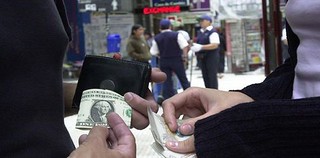 Boasting to be the second largest economy in South America behind Brazil, Argentina currently owes US$40 billion to the IMF, with inflation close to 100%, almost 40% of its population living under the poverty line and 60% of minors hungry or undernourished.
Boasting to be the second largest economy in South America behind Brazil, Argentina currently owes US$40 billion to the IMF, with inflation close to 100%, almost 40% of its population living under the poverty line and 60% of minors hungry or undernourished.
Besides the hard times for the people, this also has practical issues for the financial system, Argentina's largest denomination banknote – 1,000 pesos – is currently worth about US$ 5.40 on official exchanges, but barely reached US$ 2.65 when valued at real-world exchange rates currently.
Since its appearance in November 2017, the 1,000 pesos has lost almost 100% of its purchasing power. In 2017 it covered almost half of the basic basket and today it does not reach 6%. Today to go to the supermarket you have to carry a bag of banknotes. Logistically it is a disaster,
he said.
Amid the surge in prices, Argentines have been forced to carry hundreds of banknotes to pay for ordinary purchases, with transactions becoming increasingly difficult due to the need to use a greater number of bills.
Now, according to the sources in the banking industry, Argentina's banks are simply running out of storage room to pile the rapidly depreciating banknotes.
Reportedly, Banco Galicia and the local unit of Spain's Banco Santander have been forced to install additional vaults to store peso bills.
Banco Galicia has already added eight vaults for cash storage over the past year to the two it had since 2019, and reportedly plans to set up two more in the coming months.
The country's banks and business groups have been calling on the regulator to print higher-value bills for years, saying it would make the system more efficient for banks, businesses and citizens.
Dick adds:
"You know things are bad when the banks need bigger vaults to store the paper money. Makes me think of the captain movie Jaws - We're going to need a bigger boat."
To read the complete article, see:
Argentine banks short of storage capacity to pile the rapidly depreciating Pesos
(https://en.mercopress.com/2023/01/26/argentine-banks-short-of-storage-capacity-to-pile-the-rapidly-depreciating-pesos)
LEAVING $2 BILLS INSIDE HOTEL BIBLES
Two dollar bills are fun - they're different and eye-catching. We've run any number of articles about people using twos. Here's one about someone leaving them in hotel bibles. -Editor
Check out this Instagram hashtag: #2dollarbible. You'll find photos of $2 bills next to hotel room bibles. In a five-month-old Reddit post, u/pvdnyc claims to be the originator. He said: "I hide $2 bills in bibles in hotels with notes. #2dollarbible."
The notes offer homespun advice.
"Stop faking. Be real," says one.
"Change is good. You go first," says another.
To read the complete article, see:
Someone has been leaving $2 bills inside hotel bibles and asking people to post photos to #2dollarbible
(https://boingboing.net/2023/01/26/someone-has-been-leaving-2-bills-inside-hotel-bibles-and-asking-people-to-post-photos-to-2dollarbible.html)
THE WALT DISNEY $100 BILL
In the duuuh-yes-this-is-satire department, an article declares that Walt Disney's image will soon grace the $100 bill. -Editor
The $100 bill is by far the most popular currency denomination in America. It's not the most commonly used bill, however it consistently ranks as America's favorite bill. Oftentimes people call them Benjamins
or Bennys
after Benjamin Franklin, who is featured on the $100 bill. However, in 2023, there will be a new face on the front of the $100 bill and a new back to it as well.
It was just announced that Walt Disney will be taking over the $100 Bill in 2023. The Walt Disney Company will be celebrating their 100th anniversary in 2023. Disney will be selling special merchandise, decorating their theme parks, and apparently take over US currency as a way to celebrate this platinum milestone.
It is no surprise Walt Disney is being honored by having his face put on $100 bills. After all, he started one of the most successful companies in America, which continues to grow and thrive every year. As mentioned in The Carousel of Progress, Walt was as American as anyone could possibly be. He stood for everything America and progress and building towards a brighter future. The US could not have picked a better person to be featured on the $100 bill.
This Walt Disney hundred dollar bill will only be printed for a year and a half, during the Disney 100th anniversary celebration. The Walt Disney bill will be available on January 1st, 2023 and the last print run will be on June 1, 2024, the last official day of Disney's 100th anniversary celebration. This bill will be legal tender that can be used at any store, like any other US currency.
As you can see in the picture earlier on in the article, the front of the $100 bill has a picture of Walt Disney where Benjamin Franklin usually is. We were not provided an image of the back of the bill, however we were told it will have a design similar to Disney Dollars, featuring different Disney characters and rides, but will be in the style of US paper currency.
We expect these Walt Disney $100 bills to be extremely hot and banks to sell out of them on the first day they are available. People will be clamoring to get their hands on an exclusive Walt Disney hundred dollar bill. Don't be surprised when you see these bills listed on eBay selling for well over $100.
I shared this with Ben Franklin's alter ego Pat McBride, and we agree that "It's all about the Walts" just doesn't have the same ring to it. -Editor
To read the complete article, see:
Walt Disney Taking Over The $100 Bill In 2023
(https://mousetrapnews.com/walt-disney-taking-over-the-100-bill-in-2023/)
To read other articles, see:
Walt Disney to Replace Benjamin Franklin on the $100 Bill: Report
(https://www.disneydining.com/walt-disney-100-bill-bb1/)
Is Walt Disney Replacing Ben Franklin on the $100 Bill?
(https://www.snopes.com/fact-check/walt-disney-100-dollar-bill/)
LOOSE CHANGE: JANUARY 29, 2023
Here are some additional items in the media this week that may be of interest. -Editor
Greg Reynolds published an article in the Greysheet about the unique 1870-S Half Dime. -Editor
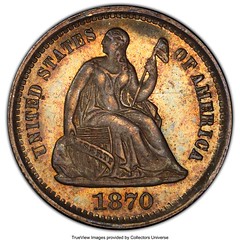 On January 11, the unique 1870-S half dime realized $3,120,000. Incredibly, the only three privately owned, unique U.S. coins were all in the same FUN auction extravaganza, from three different consignors.
On January 11, the unique 1870-S half dime realized $3,120,000. Incredibly, the only three privately owned, unique U.S. coins were all in the same FUN auction extravaganza, from three different consignors.
A coin is unique if only one is known in the present. The discovery of the unique 1870-S half dime during the late 1970s was a shock to the coin community. Research by Nancy Oliver and Richard Kelly has since demonstrated that San Francisco Mint officials made preparations and filed paperwork for coins of all then current denominations to be struck and placed in a cornerstone of the San Francisco Mint in 1870. In 1978, however, few coin collectors thought that an 1870-S half dime existed. An 1870-S quarter has never emerged.
To read the complete article, see:
Tom Bender's Collection, Review Part 3: Unique 1870-S Half Dime
(https://www.greysheet.com/news/story/tom-bender-s-collection-review-part-3-unique-1870-s-half-dime)
A Numismatic News by Ken Potter discusses the 1958 Doubled Die Cent. -Editor
A legendary example of the ultra-rare 1958 doubled die Lincoln cent smashed all records for the sale of any doubled die sold at auction by exceeding the virtually unfathomable $1 million mark! The 1958 doubled die cent boasts very strong doubling with only three specimens known. It is comparable to the 1955 and 1972 doubled die cents. GreatCollections of Irvine, Calif., handled the sale where it received 117 bids and was hammered down at $1,136,250 with buyer's fee on Jan. 22 at 3:33 p.m. PST. GreatCollections described it as:
The King of Doubled Dies. The finest of only three examples known, and in its first auction appearance. Missing from all major collections of Lincoln Cents. Severe doubling, similar to 1955. This variety was first reported in the early 1980s and has severe doubling of IN GOD WE TRUST and LIBERTY.
The 1958 doubled die was featured in the appendix of The Lincoln Cent Doubled Die by John A. Wexler in 1984 as a last-minute addition. Everybody who saw it in Wexler's book wanted one! The very next year I would have the honor to hold one in my hand and meet the owner, Charles Ludovico of Pennsylvania. My first one in hand was at Combined Organizations of Error Collectors of America's (CONECA) Errorama held in conjunction with the Garden State Numismatic Association in 1985, and then I had the honor to hold a second specimen in hand was at Errorama 1986, held at the same location.
Ludovico was quite a few years older than I am and he is surely gone by now, but I wonder what he'd think to see one of his pennies fetch more than a million dollars!
To read the complete article, see:
1958 Doubled Die Cent Smashes Records
(https://www.numismaticnews.net/us-coins/1958-doubled-die-cent-smashes-records)
Who says you can't take it with you (to bed)! A Korean Bank has created the "Money Dream Pillow" with recycled banknotes. -Editor
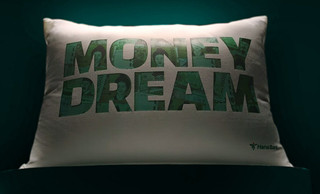 A Korean bank's unique campaign has recently become the talk of the town.
A Korean bank's unique campaign has recently become the talk of the town.
Hana Bank (CEO, Lee Seung-yeul), one of Korea's four major banks, is introducing 'Money Dream' campaign to boost the bank's digital platform and give "wealth energy" to customers by providing eco-friendly pillows made with unfit banknotes.
Many Koreans believe that having a bank-made item at home can bring wealth to the household that owns it. Hana Bank played on this superstition and created a pillow called 'Money Dream' which can be read in Korean as 'giving money'. Made with recycled unfit banknotes, The 'Money Dream' pillows have become popular lucky draw gifts to Hana bank's customers.
Hana Bank expects 'Money Dream' campaign to provide customers with the opportunity to feel the "wealth energy" stuffed in their pillows while protecting the environment.
To read the complete article, see:
Hana Bank's ?Money Dream? Campaign for Recycling Unfit Banknotes
(https://www.prnewswire.com/news-releases/hana-banks-money-dream-campaign-for-recycling-unfit-banknotes-301731452.html)
THE MONEY ART OF VICTOR DUBREUIL
Pablo Hoffman passed along a great article on the money art of Victor Dubreuil. Thank you. Here's an excerpt. -Editor
After supposedly stealing 500,000 francs from his bank, the mysterious Victor Dubreuil (b. 1842) turned up penniless in the United States and began to paint dazzling trompe l'oeil images of dollar bills. Once associated with counterfeiting and subject to seizures by the Treasury Department, these artworks are evaluated anew by Dorinda Evans, who considers Dubreuil's unique anti-capitalist visions among the most daring and socially critical of his time.
In October 1893, an unidentified reporter for the New York World visited Victor Dubreuil's studio on West Forty-Fourth Street to ask him about his deceptively realistic paintings of United States currency. Several of his pictures had drawn public interest when they were displayed over the bar in a Seventh Avenue saloon. What the journalist found, when the door opened, was a kindly, fifty-one-year-old, virtually penniless Frenchman who spoke heavily accented English and shared his accommodations with a young nephew. As the writer described Dubreuil, the artist had a bent, portly form, dark eyes, and a grizzled black beard. When he went out, he wore a wide-brimmed black hat. This recently recovered journalist's interview reveals an educated man of strong opinions and many talents. And it helps fill a longtime gap in basic knowledge about Dubreuil and his cryptic, socially-critical images.
Born to middle-class parents on November 8, 1842, he was baptized Marie Victor The´odore Dubreuil in the town of Ayron, near Poitiers. On the record, his father is listed as a landowner. From what is known, Dubreuil joined the French army as a soldier in his twenties and fought in the Second Franco-Mexican War as well as the Franco-Prussian War. Then he settled in Paris, working as the director of an exchange bank. On May 29, 1878, at age thirty-five, he married Virginie Lenoir, a widow fifteen years his senior. By the spring of 1881, he had become a socialist agitator and co-founder of a short-lived newspaper called La politique d'action. He also tried to found a norm-breaking African development company. According to his interviewer, the company would do for France and Africa what the East India company did for England and India
, with the difference that the workingman, not the capitalist
would reap the financial rewards. Apparently as part of this effort, Dubreuil stole more than five hundred thousand francs from his bank — in an action he justified as borrowing — leaving it bankrupt. On October 29, 1881, the Parisian newspaper La revue e´conomique et financie`re carried a short notice of Dubreuil's disappearance and speculated that he had gone to Holland. According to the paper, an extradition warrant had been issued against him for forgery and misappropriation of funds.
Dubreuil arrived in New York on June 6, 1882, applied for U.S. citizenship, and found short-term employment as a stable boy for the banker The´ophile Keck. In his flight to avoid prison, he left his wife behind and later divorced her. As the journalist reported, after four months of work in the stable, Dubreuil taught himself to paint still lifes, genre scenes, landscapes, and even portraits, so that he became, in his own words, vairsateel
(versatile). During these first years in the United States, he also tried to increase his earning power through rather imaginative inventions, such as a special pulley-controlled pair of suspenders. When he became a citizen in 1888, however, his certificate of naturalization listed his occupation simply as artist
.
At the time of the New York World interview, Dubreuil was best known for trompe l'oeil images of legal currency, such as Take One. Similar pictures had been produced by some of his American contemporaries, including William Michael Harnett, since at least 1877. As in Harnett's case, the illusionism of Dubreuil's bank notes drew public admiration, which is why he was pursued for an interview. The reporter described two of his larger works on view at the Seventh Avenue saloon in some detail. The first, entitled Barrels O' Money (unlocated), was an unusual depiction of unattainable wealth. It showed rows of oak casks filled with freshly minted treasury bills, topped with heaping shovelfuls
of gold coins and sparkling jewels that spilled onto the floor. The second of these two paintings — an image of a bank robbery — was considered the key
to the artist's aspirations, disappointments, joys and sorrows
. Certainly, it related to his past experience with the world of banking and his current poverty.
Now called Don't Make a Move!, the canvas, painted during a time of economic depression, is identified in the article as A Prediction For 1900; or, a Warning to Capitalists. This first title and visual evidence within the painting imply that the subject is an allegorical indictment of international banking. The artist himself, shown wearing his signature broad-brimmed hat and pointing a pistol at the viewer, and his ex-washerwoman
pose as two bank robbers who, in their coarse clothing, are ostensibly victims of financial reverses.5 They face the spectator who, in the position of bank representative, is the real culprit and, in fear, has just knocked over a stool and discarded a newspaper. As the blank account ledger shows, no records have been kept, and the money is not in any order but, rather, stashed chaotically in a drawer. In this symbolic world, the upside-down image of Martha Washington visible on the dollar bill at the top of the pile of notes in the washerwoman's outstretched right hand and the pointedly upended word United
on a nearby bank note suggest the topsy-turvy state of the country. The discarded newspaper, a fictitious international publication entitled The Sport, produced in London but on sale for five cents
, contains several satirical and anti-imperialist references, such as Russian Republic
and 1810
, the year the paper was established. This is when Mexico, Argentina, Chile, Colombia, and Venezuela rebelled and called for an end to Spanish rule. Taken together, other legible words — Salvator
, Unidos
, and Nihil
— imply crisis and general despair.
Another money painting, The Cross of Gold, derives its title not from the artist but from a famous speech that the presidential candidate William Jennings Bryan gave in the same decade in which the work was made. Bryan's address (now called The Cross of Gold Speech
) at the 1896 Democratic National Convention in Chicago attacked wealthy easterners for insisting on a gold standard for the country's currency at the expense of the average worker, who would be better off with a silver or a bimetallist standard. Bryan electrified his audience when he ended with the memorable words: You shall not crucify mankind upon a cross of gold.
Shortly afterward, a caricature of Bryan giving the speech depicted him waving a crown of thorns and holding a huge golden cross. Dubreuil's creation, however, in its striking originality, does not fit this iconography and is not convincing as the literal embodiment
, as has been argued, of a contemporaneous politician's rant. In the traditional position of the Virgin Mary is a depiction of Martha Washington, an exemplary
historical figure associated with the founding of the nation. Placed this way, she appears to be chief worshiper in a farce. The words United States
on the topmost silver certificate seem to confirm that this object of adoration can be interpreted as a satire of the country's worship of money, particularly in this time of financial difficulty.
As a painted subject, currency increased in popularity among still-life painters in New York at the end of the century. Compared with his competitors, Dubreuil was less prolific and more uneven an illusionist than most. In fact, some of his bank notes are quite loosely painted and mostly fanciful, as in a second robbery picture, A Hard Day's Work. Yet while his pictures could be cruder or less exact than those of his better-known contemporaries, they were also more strident in content. Alfred Frankenstein, who in 1953 was possibly the first art historian to mention Dubreuil, admired and reproduced Don't Make a Move! as the artist's masterpiece, later noting with approval its vein of stark brutality
. The art historian Bruce Chambers had good reason, in surveying money paintings of the period, to note that Dubreuil's images were the most individual of them all
.
See the complete article online for much more. Very interesting! -Editor
To read the complete article, see:
Illusory Wealth
Victor Dubreuil's Cryptic Currencies
(https://publicdomainreview.org/essay/illusory-wealth)

